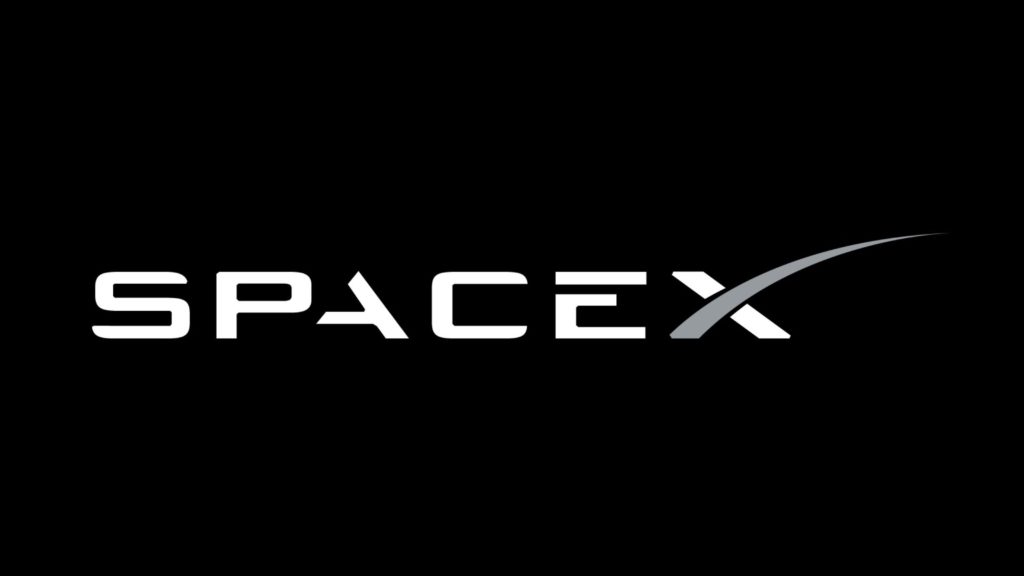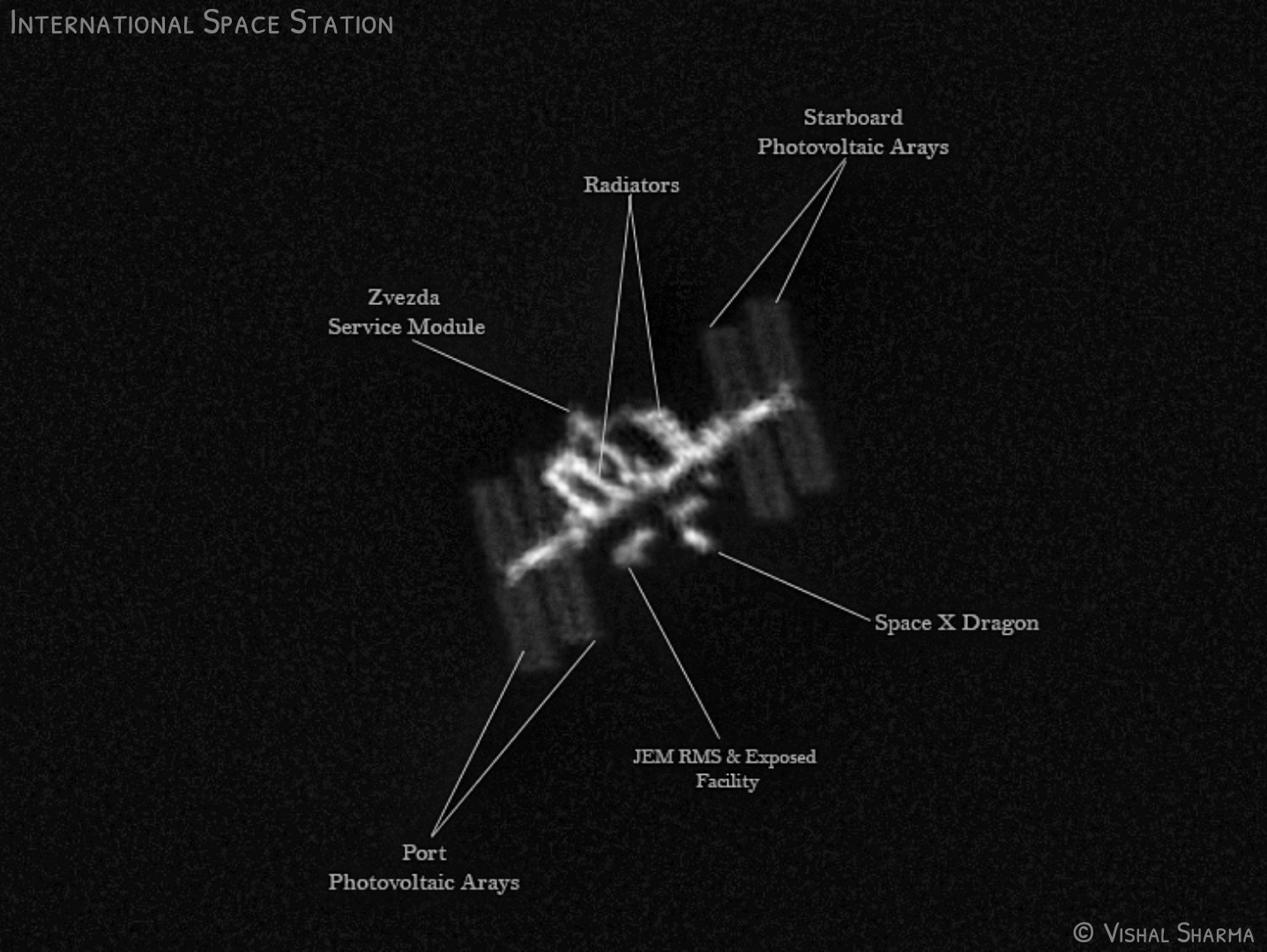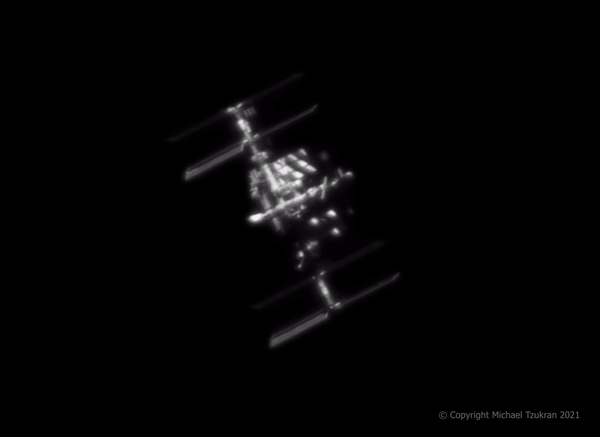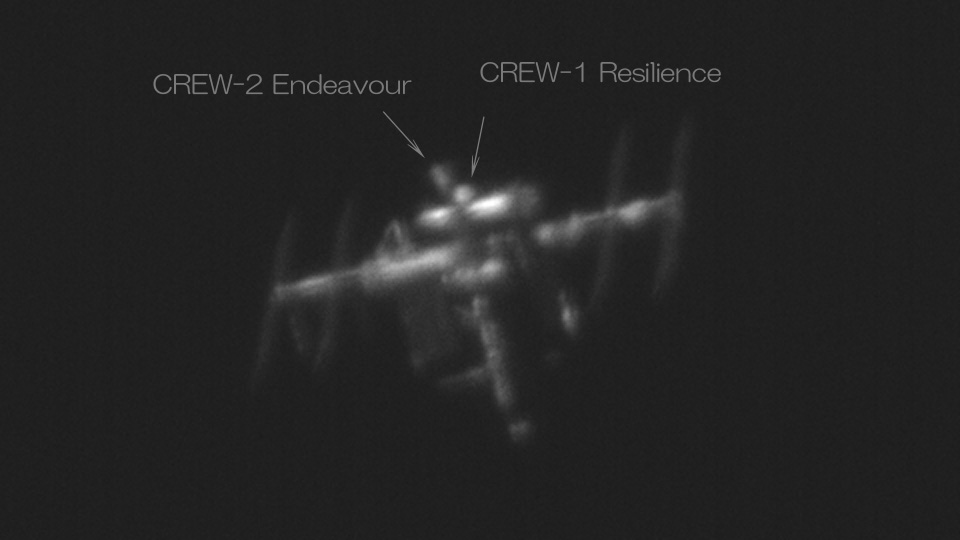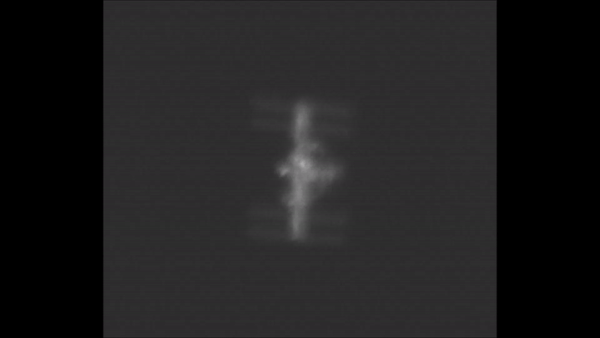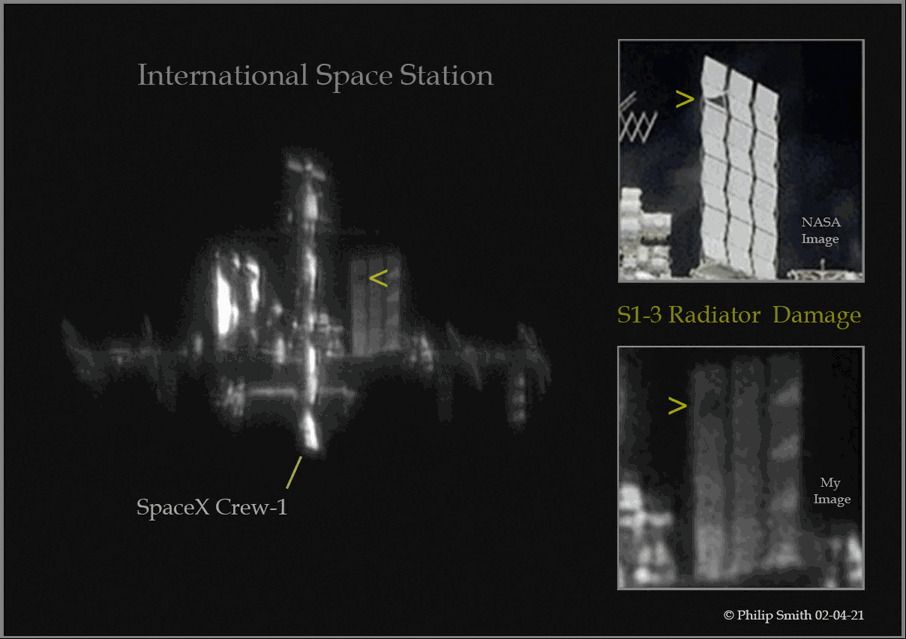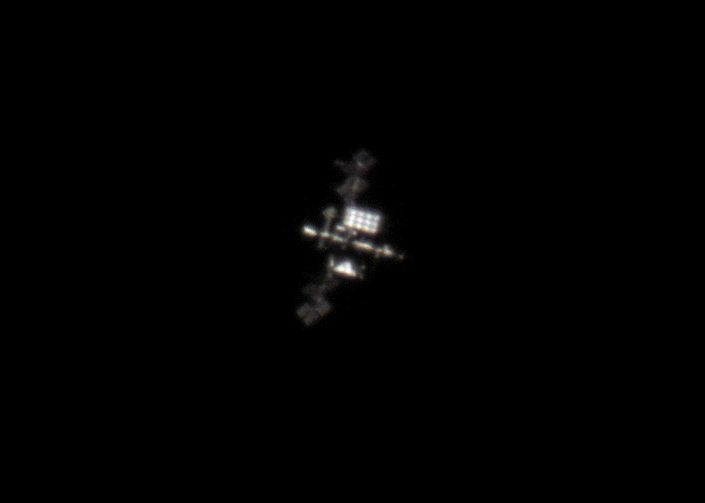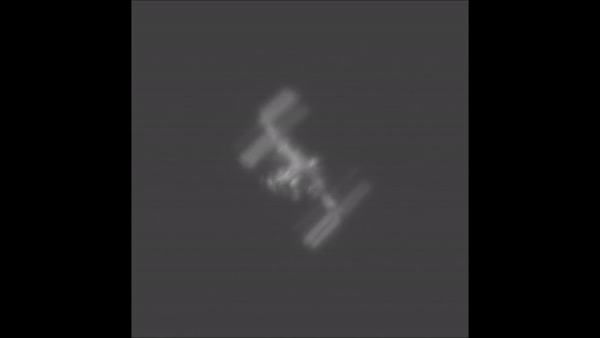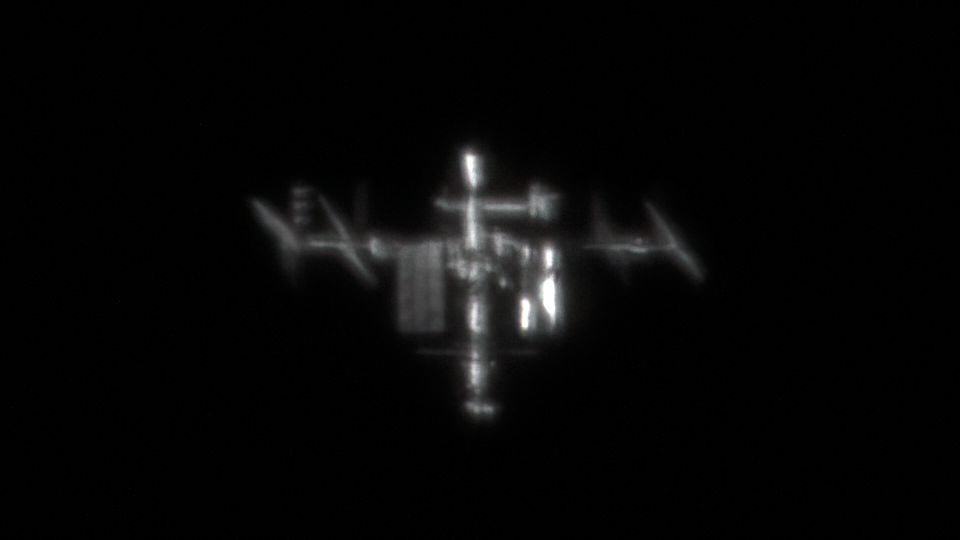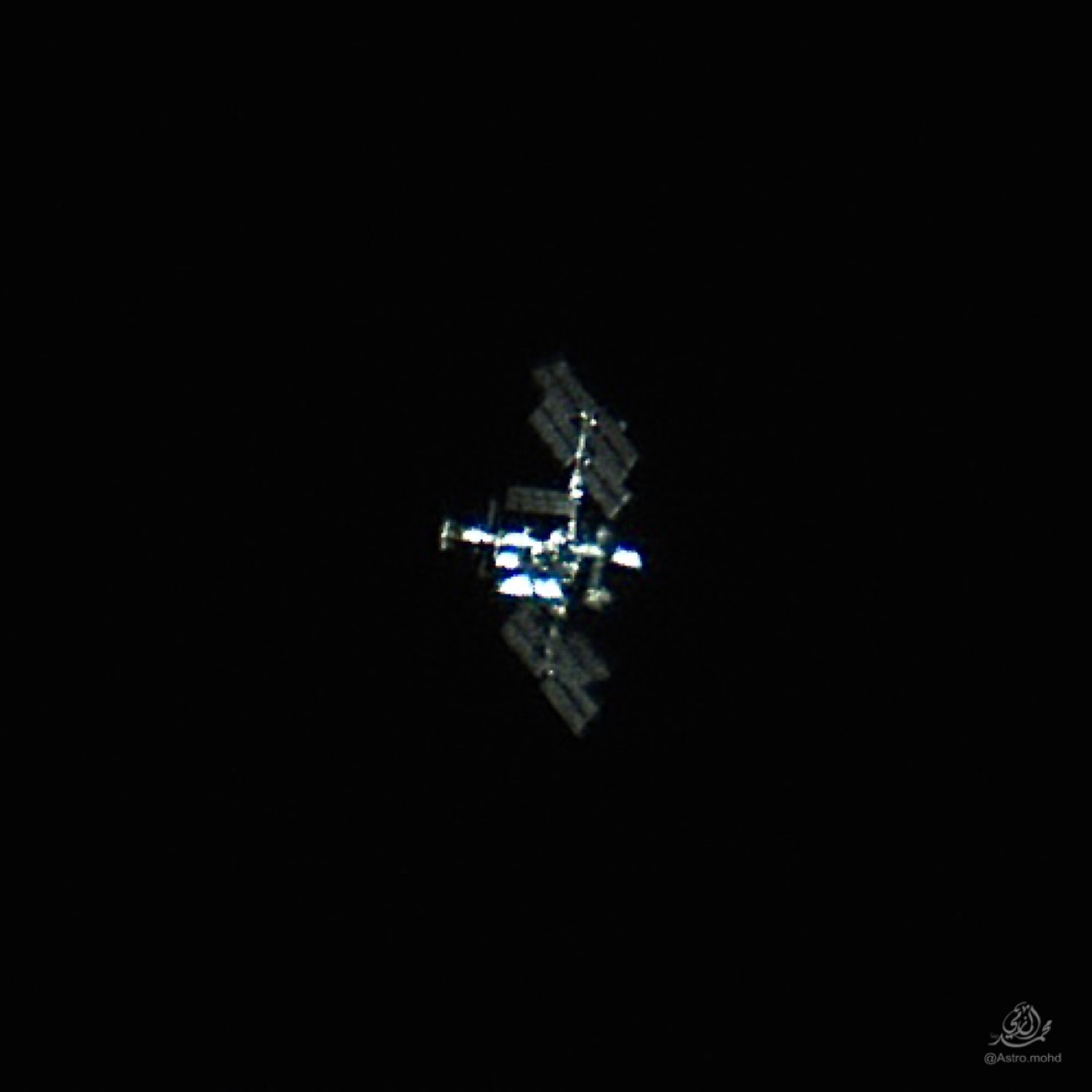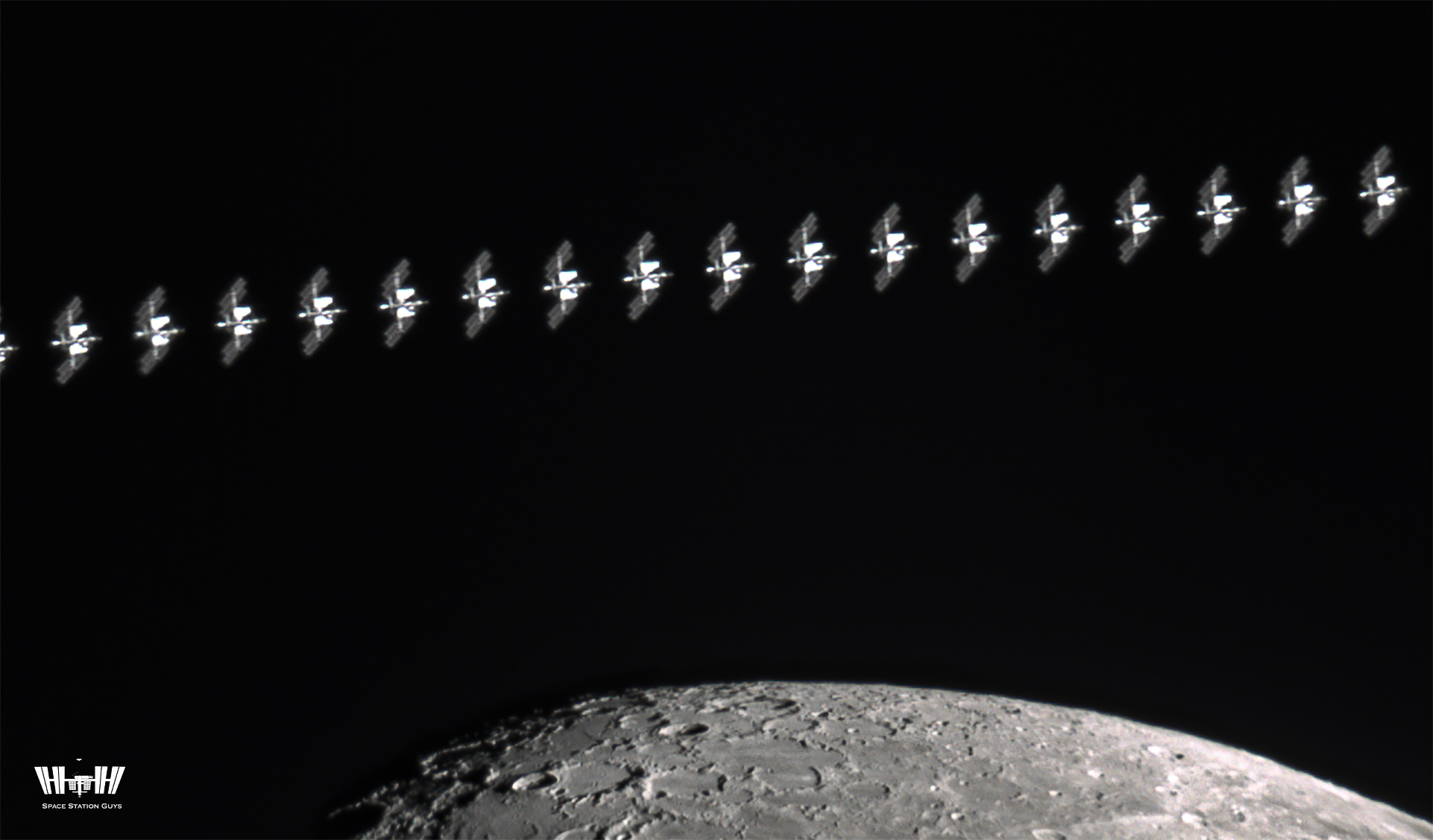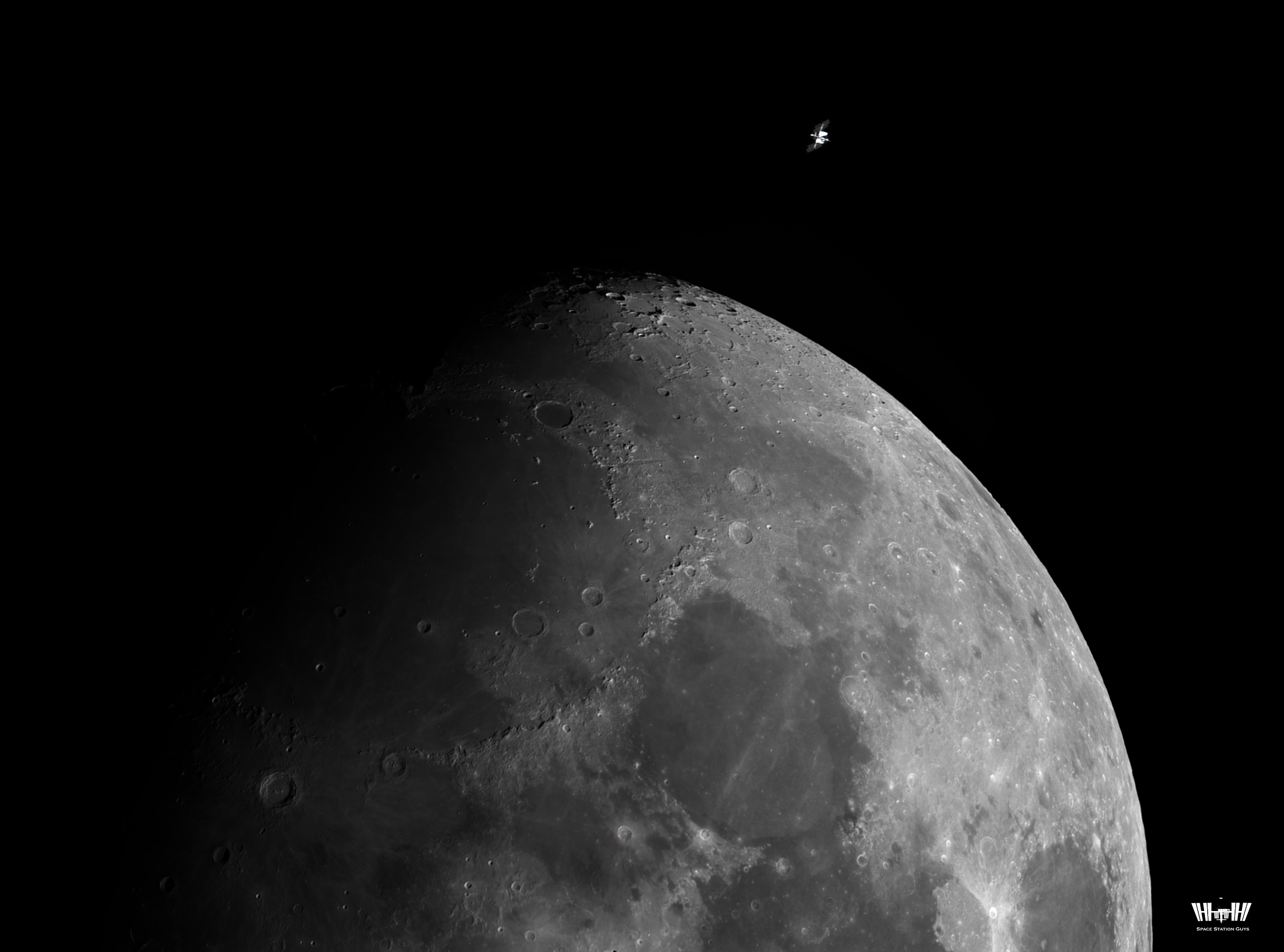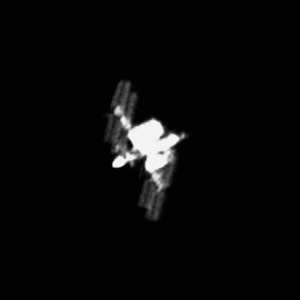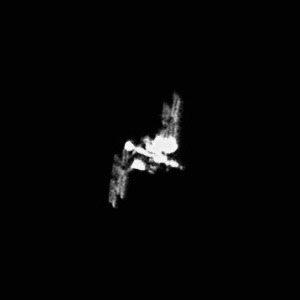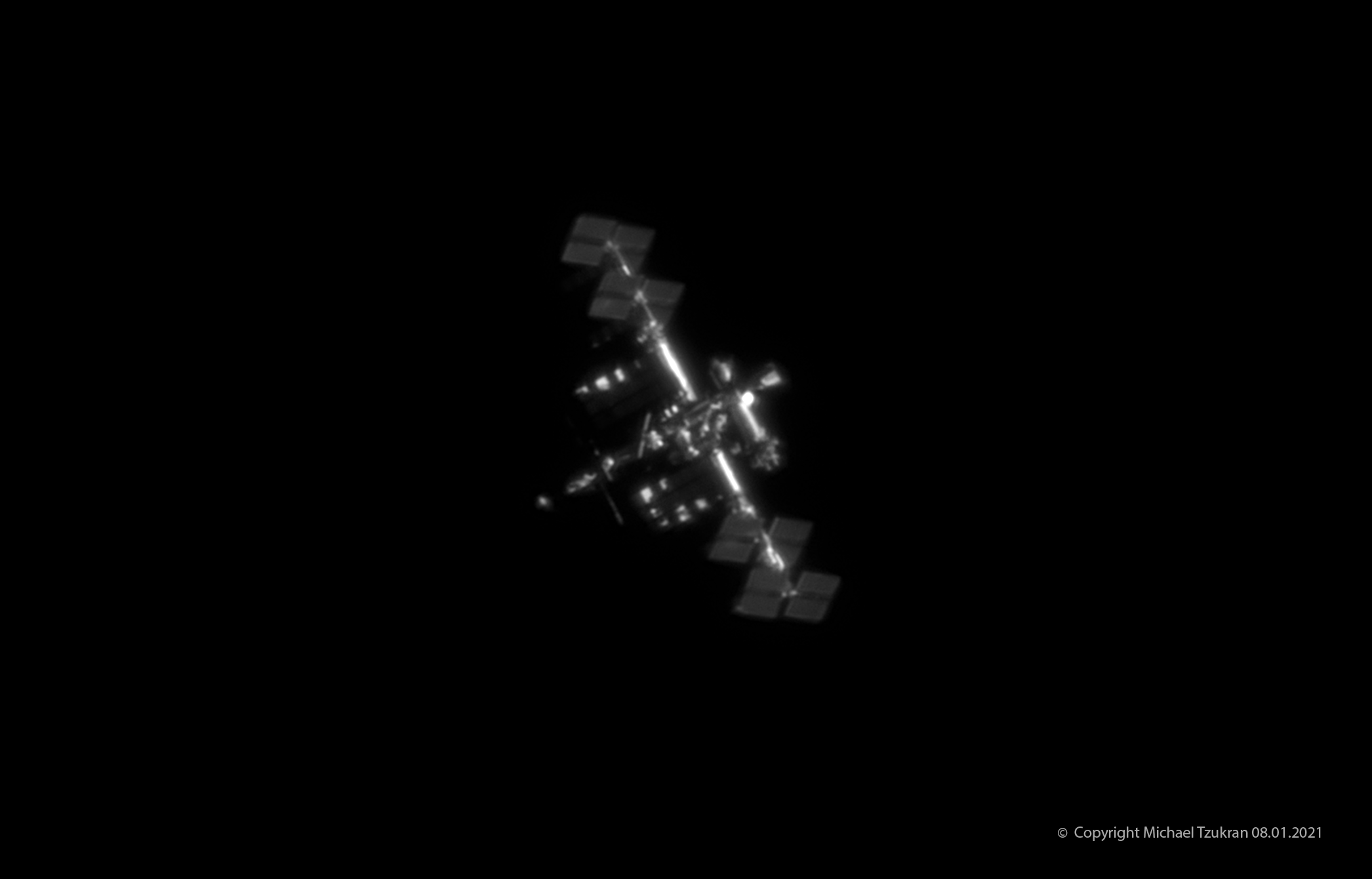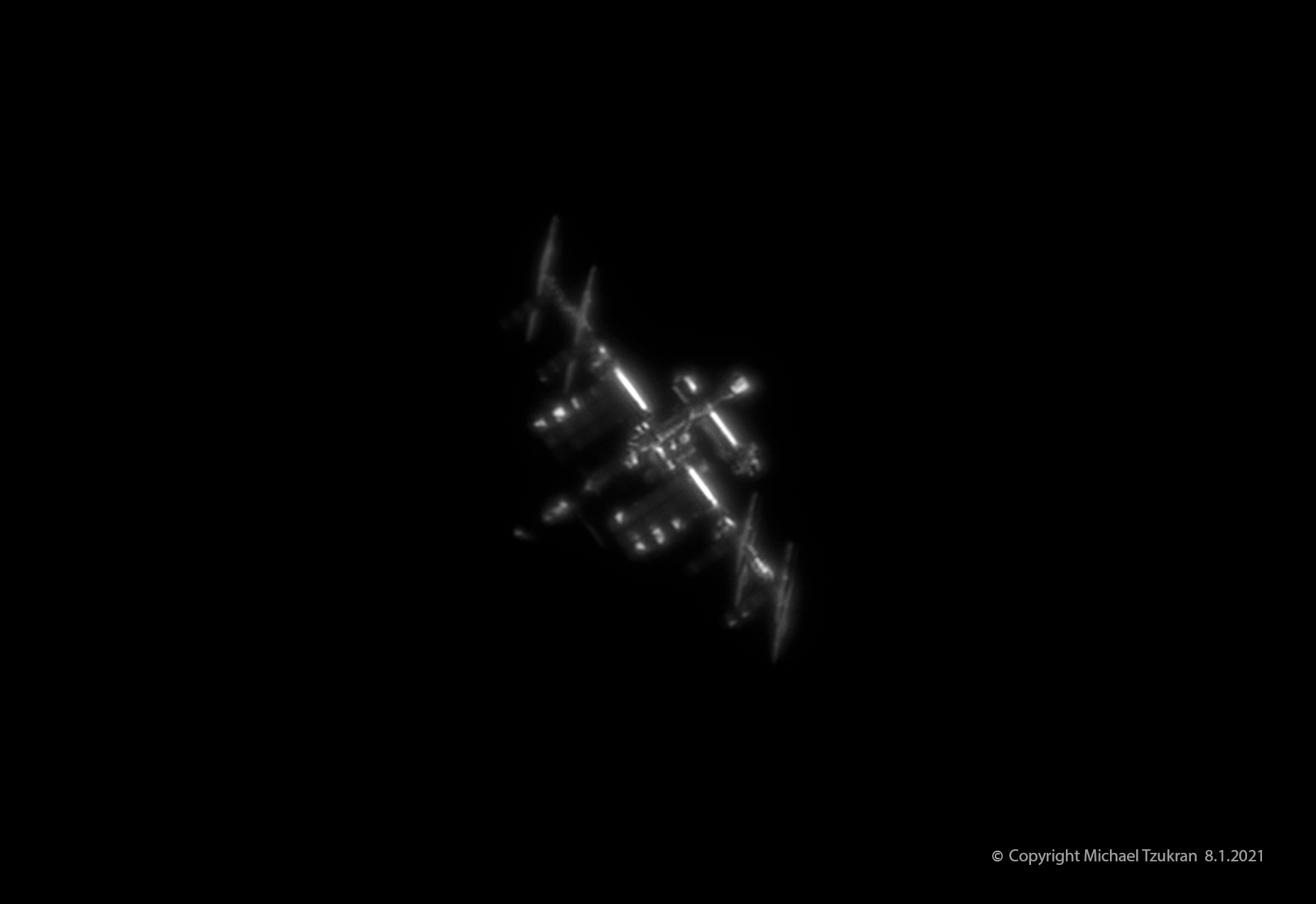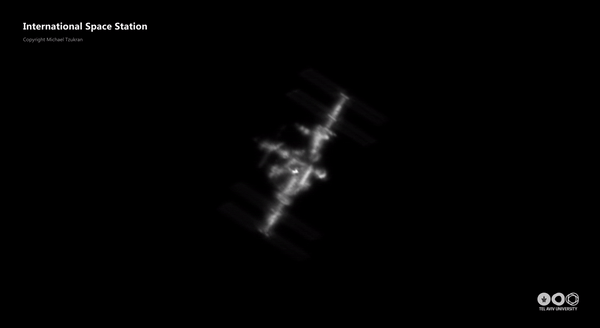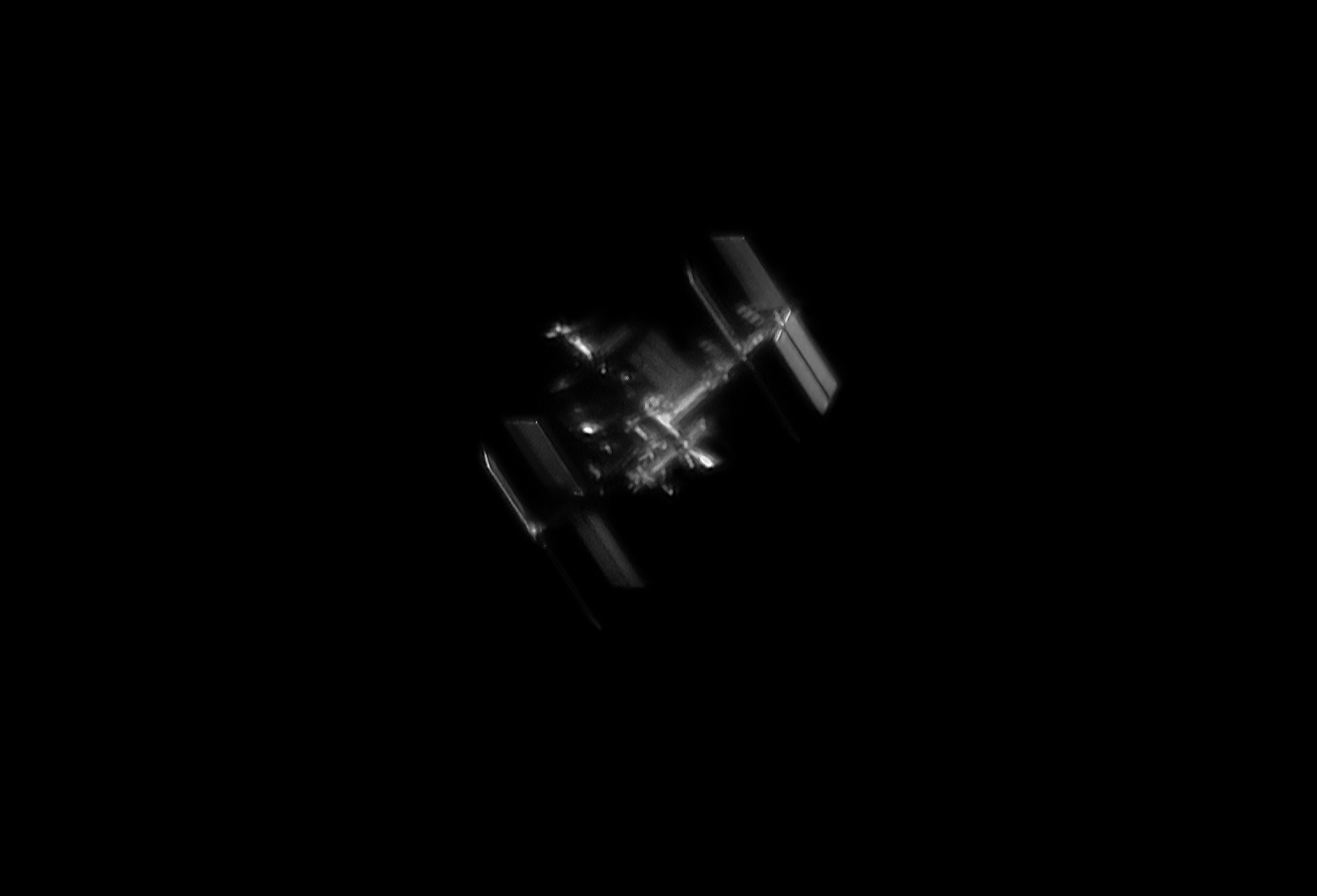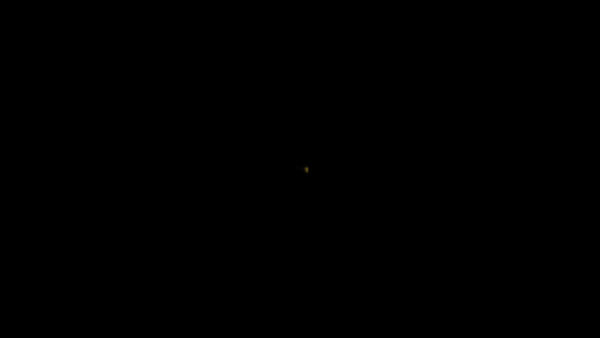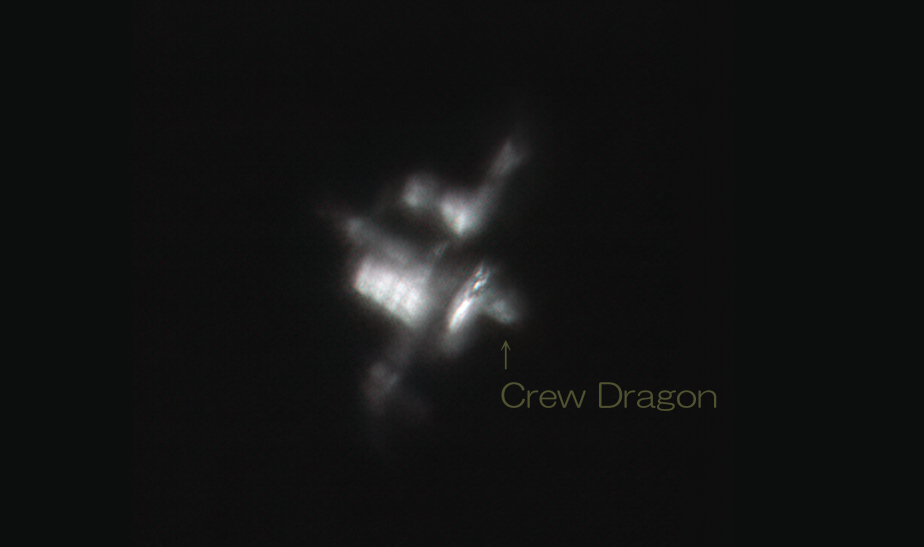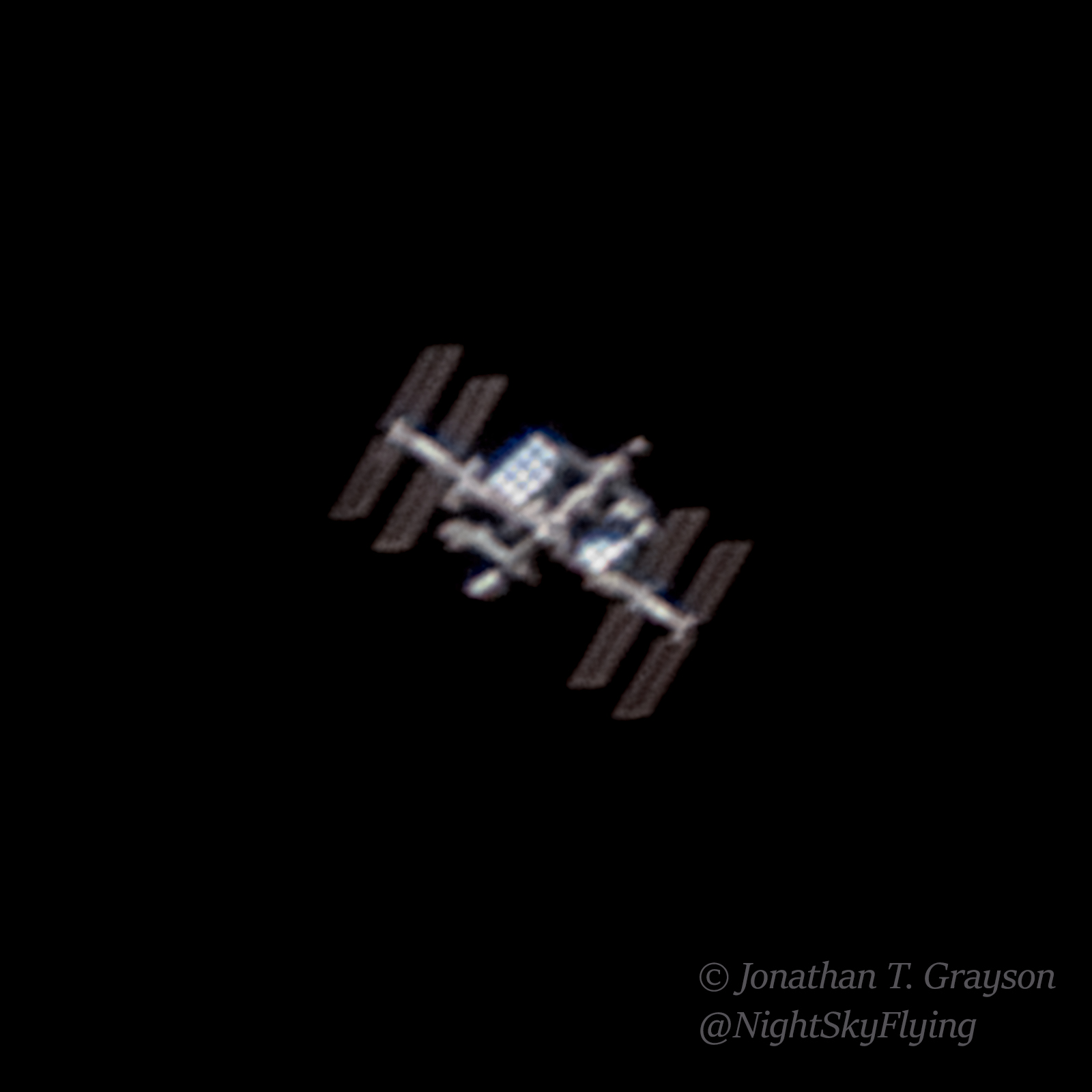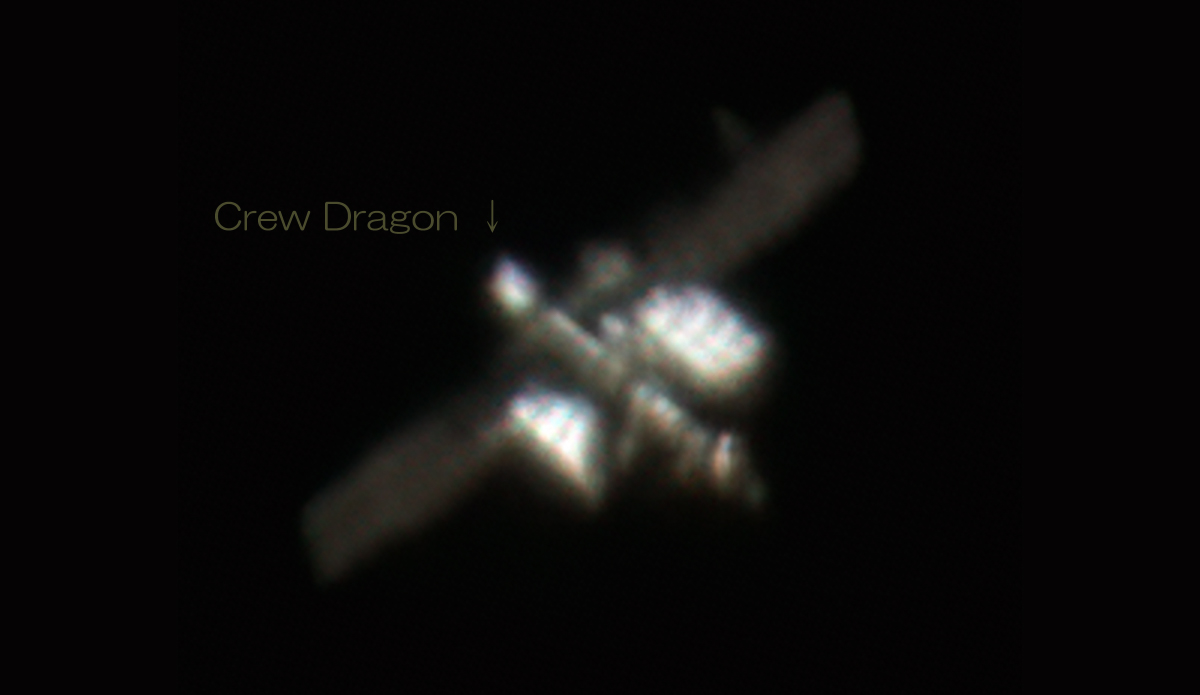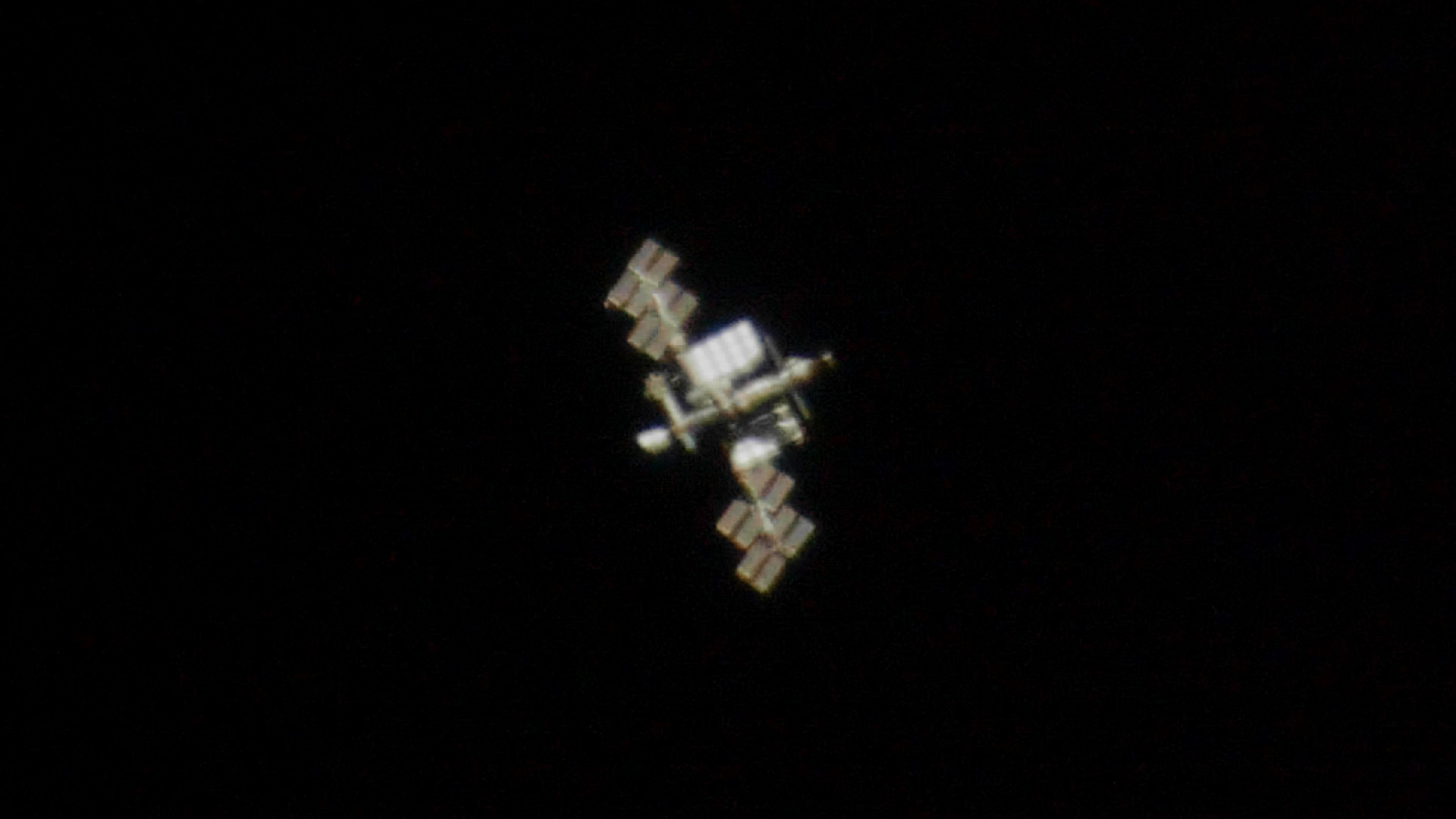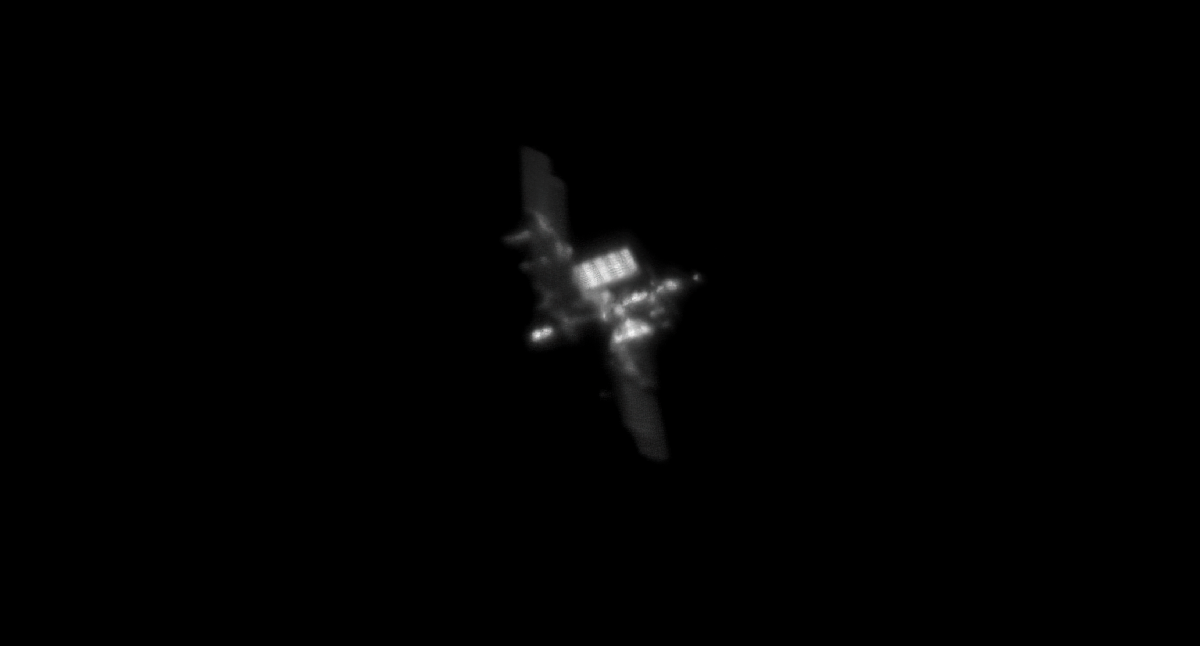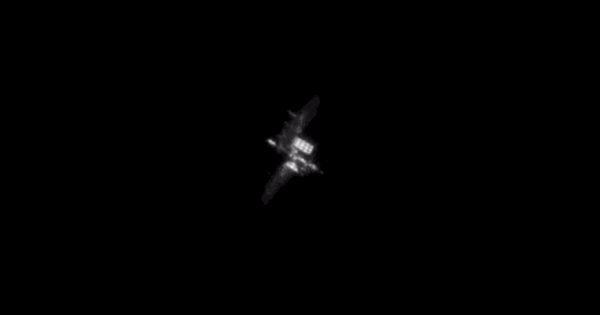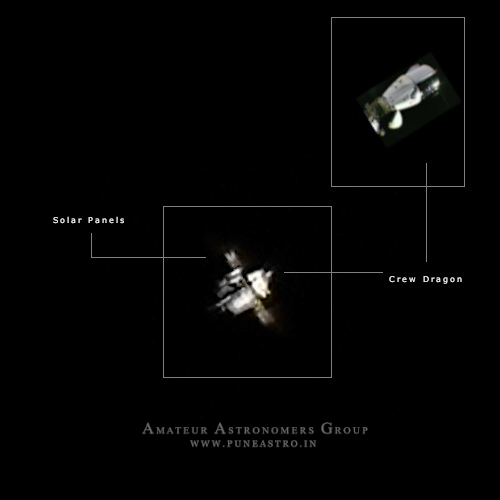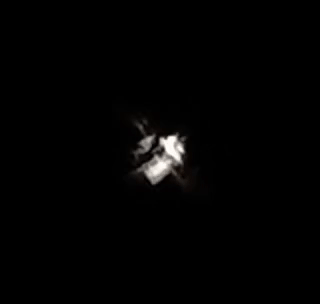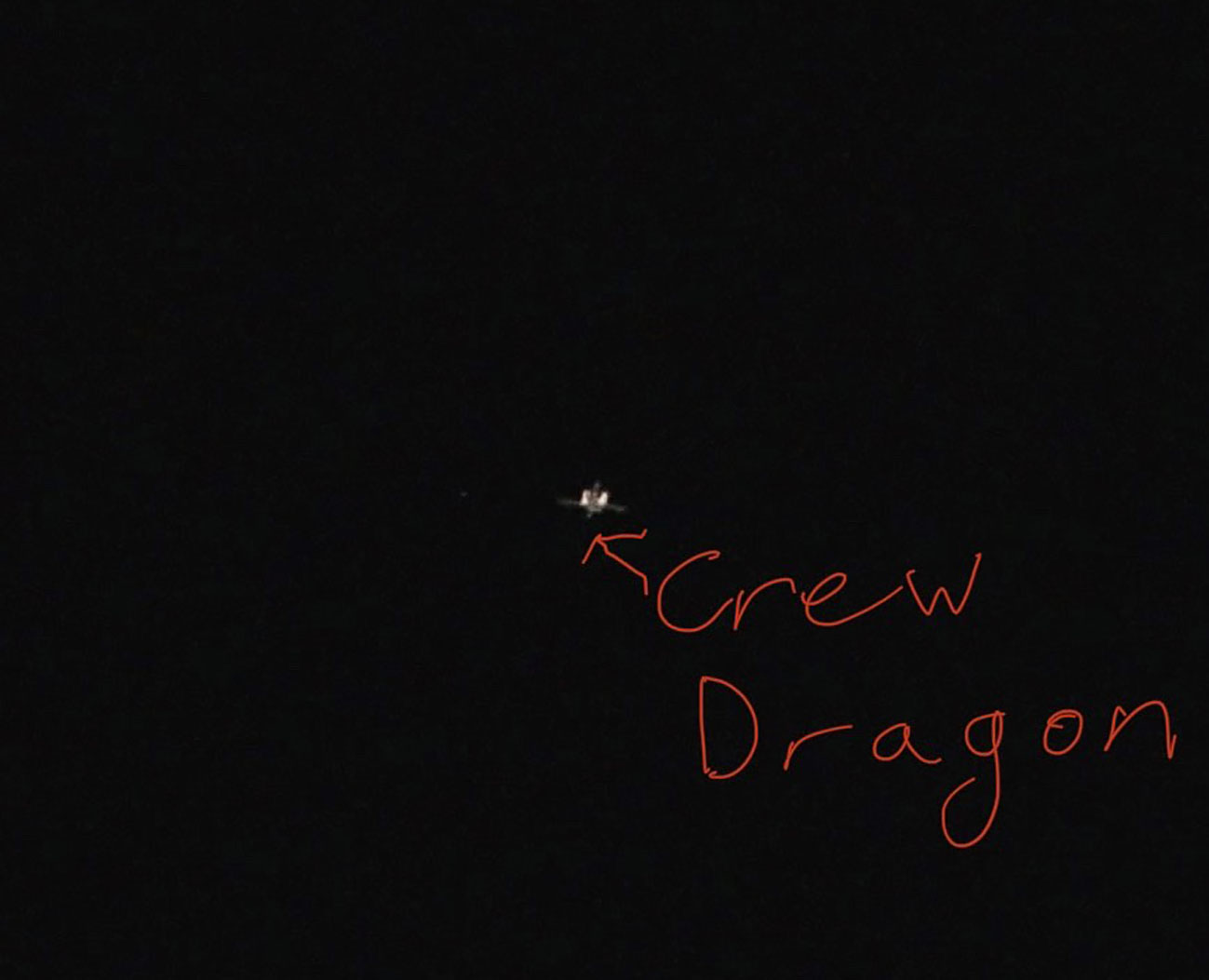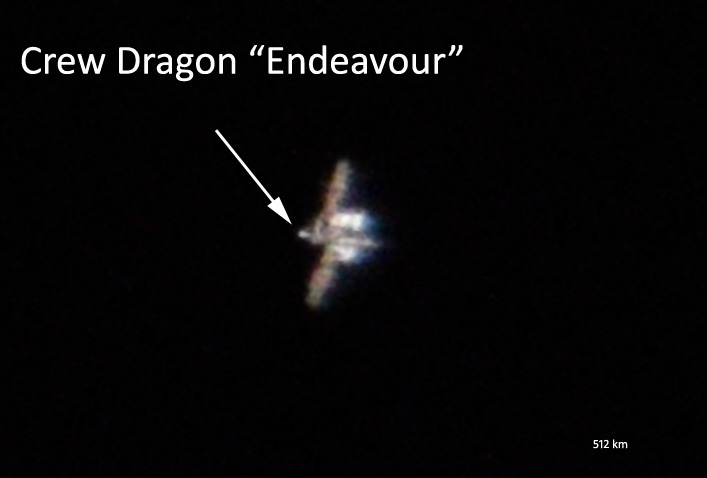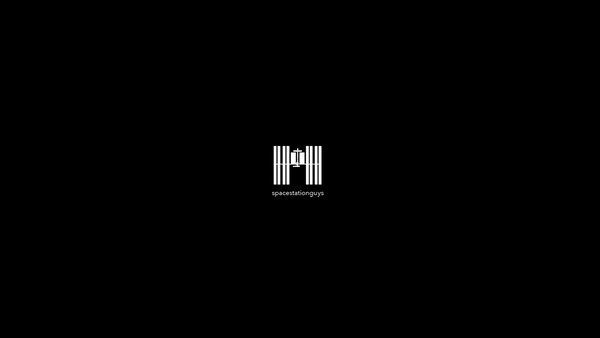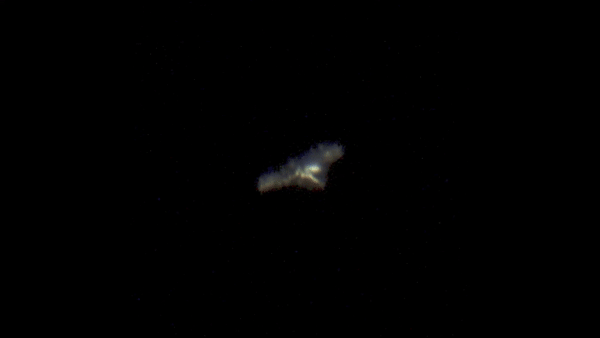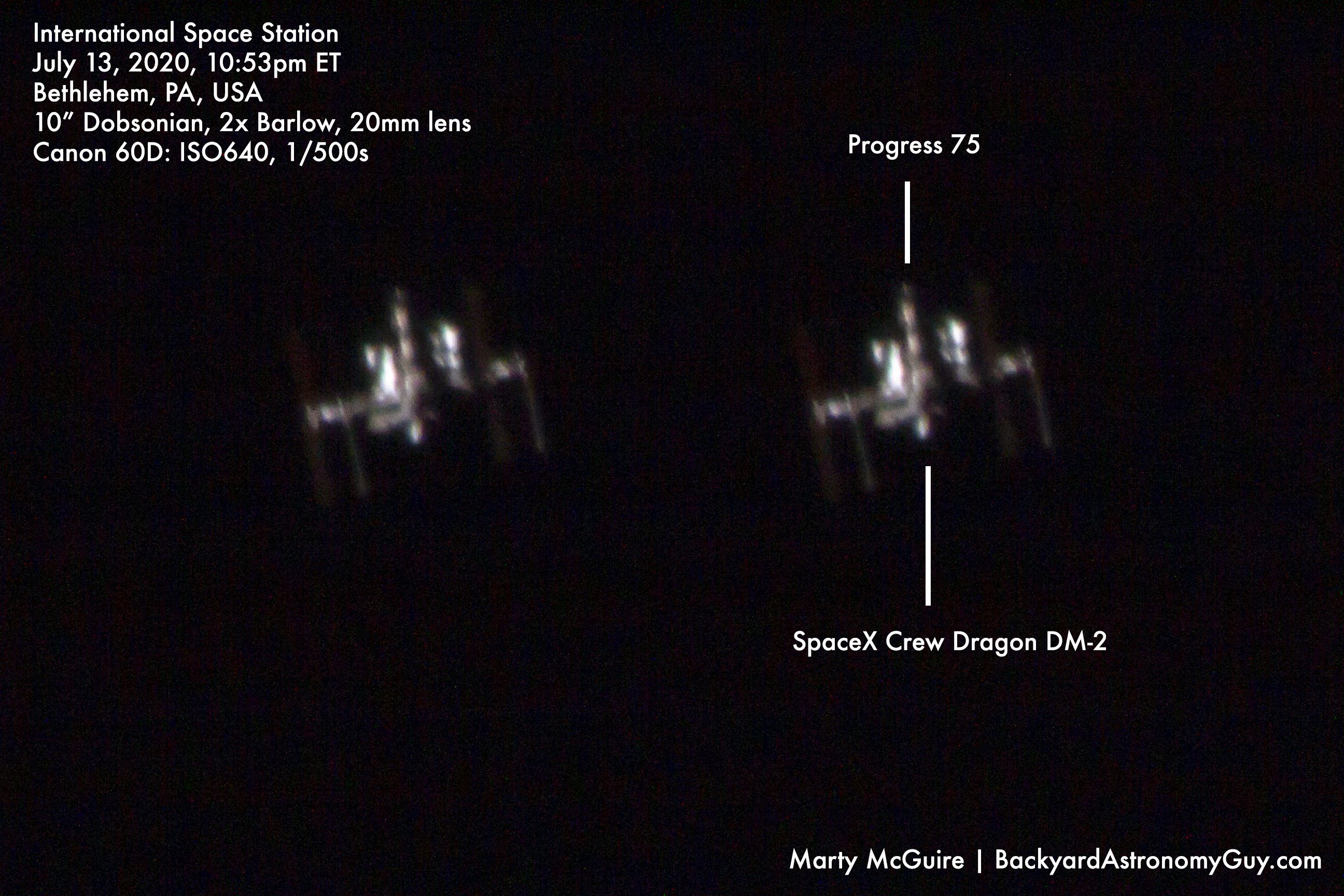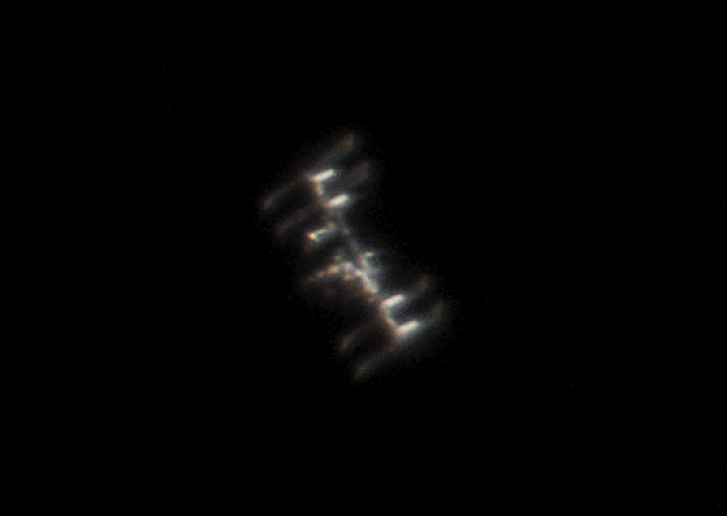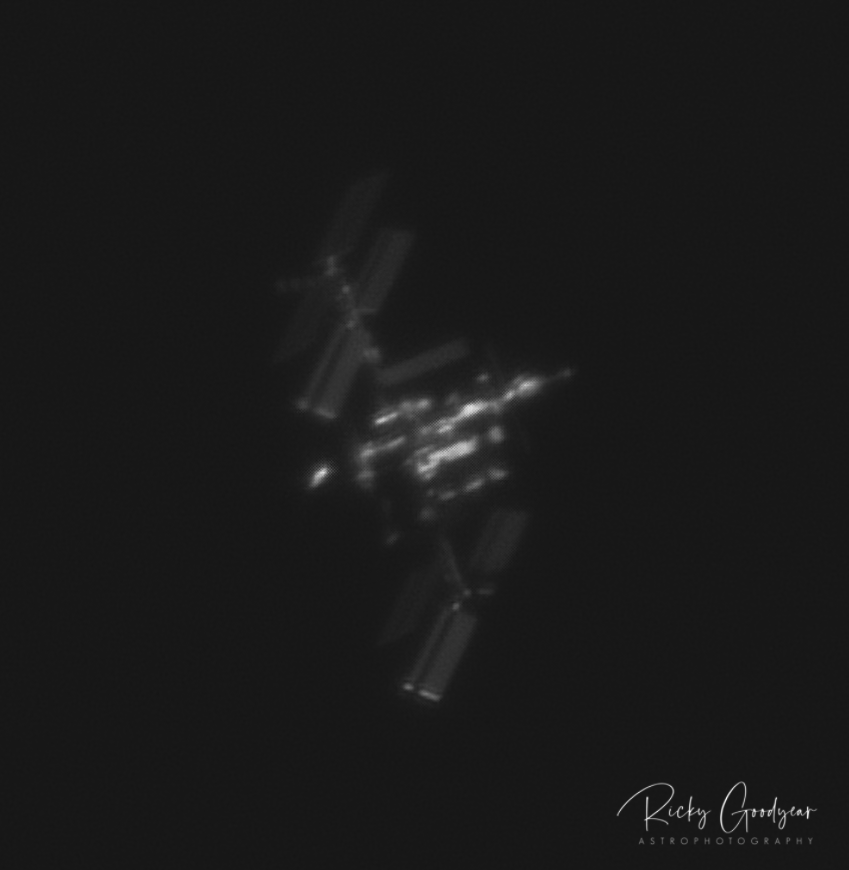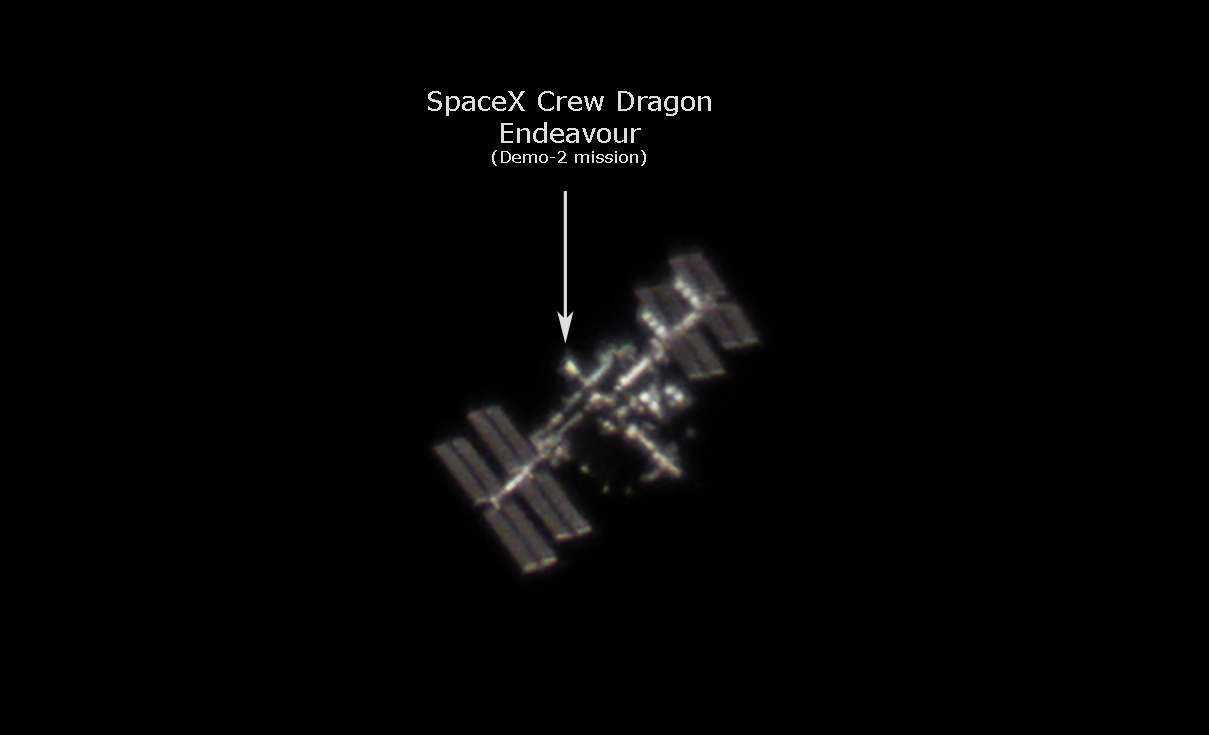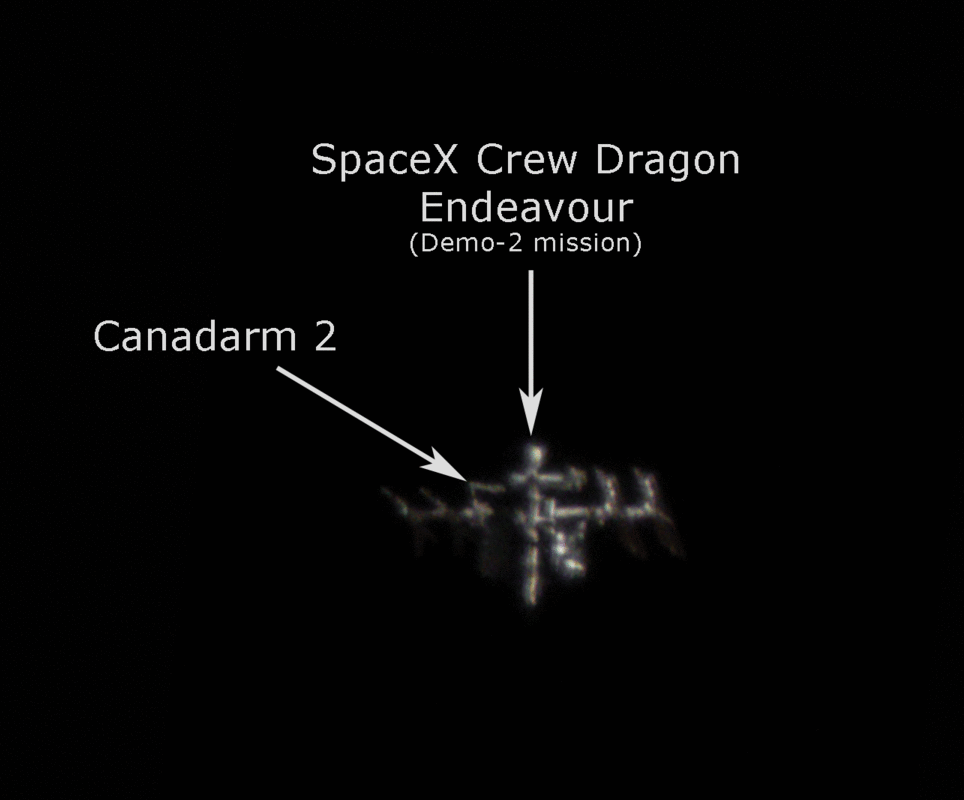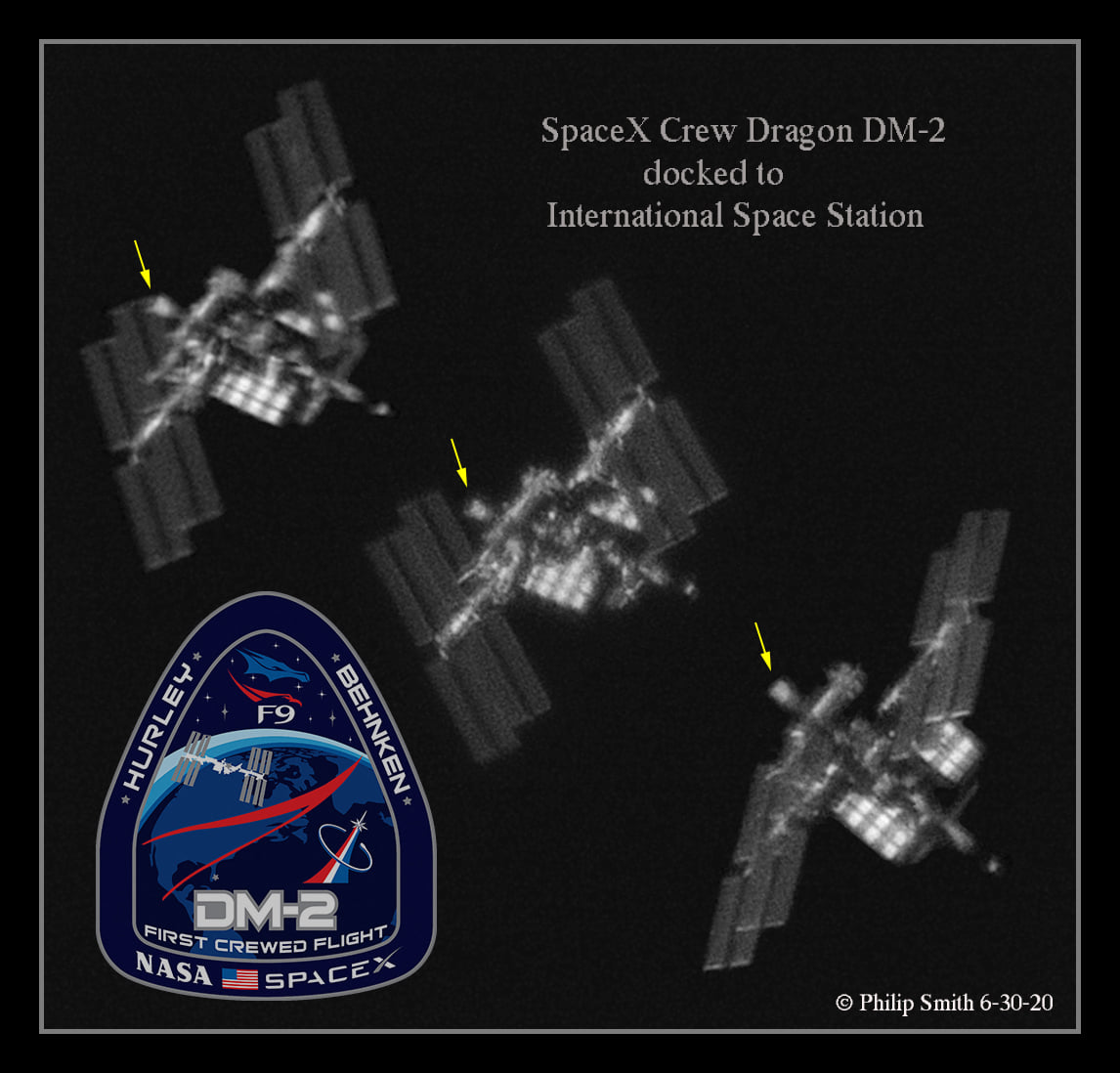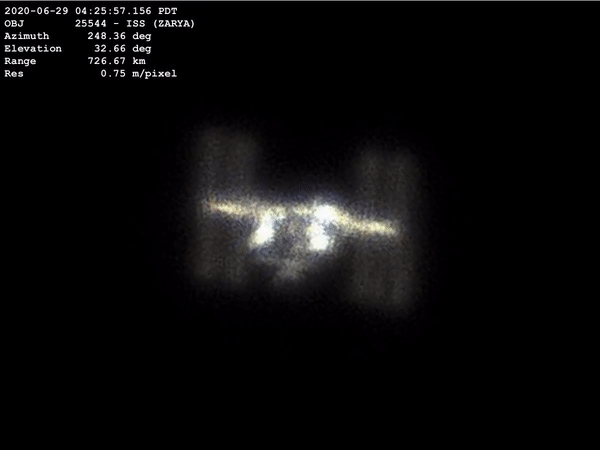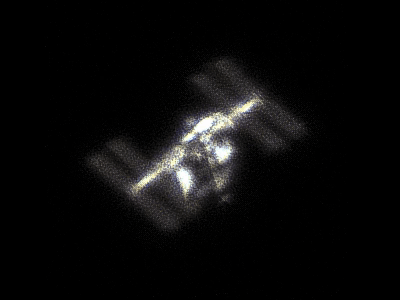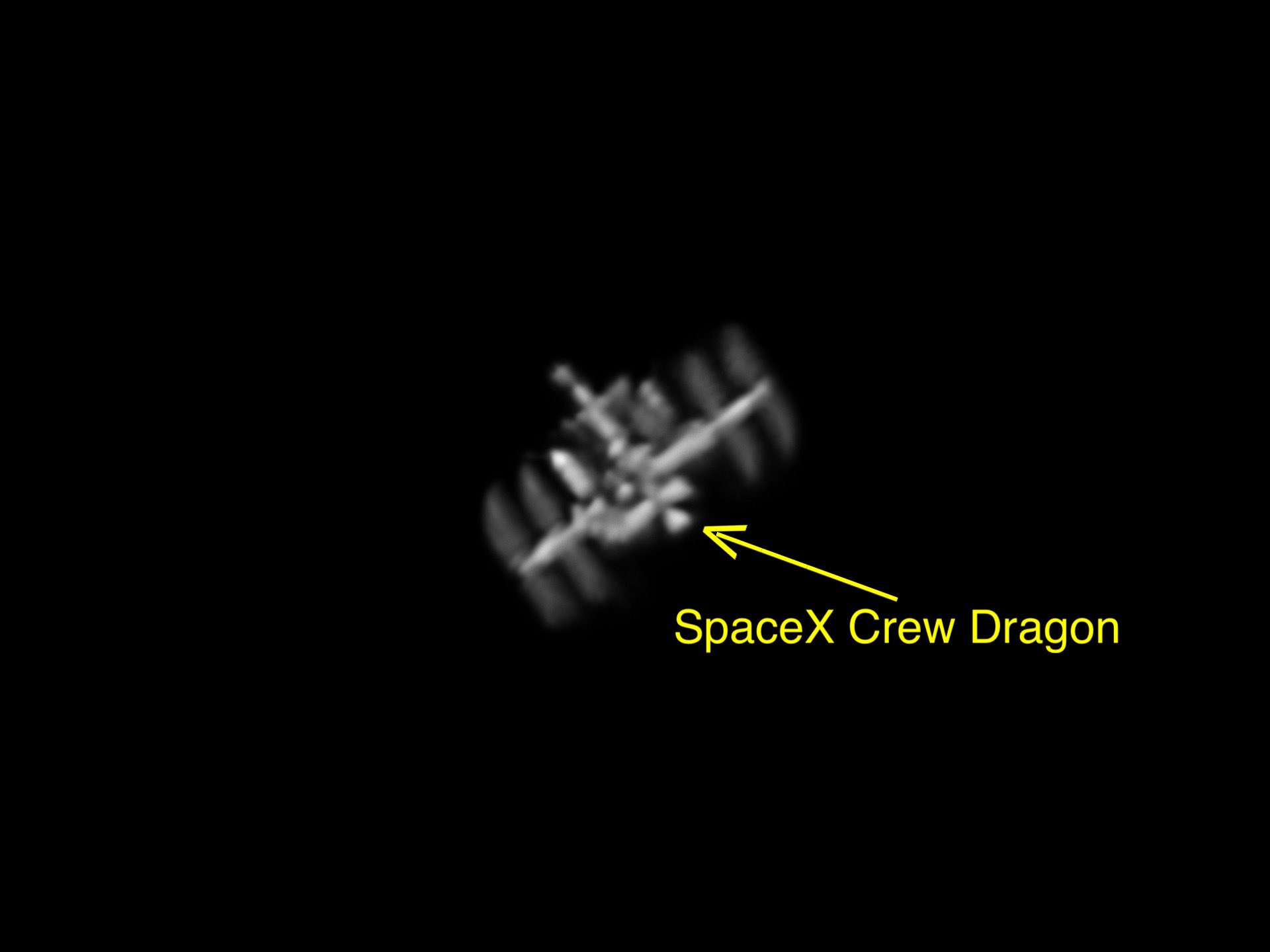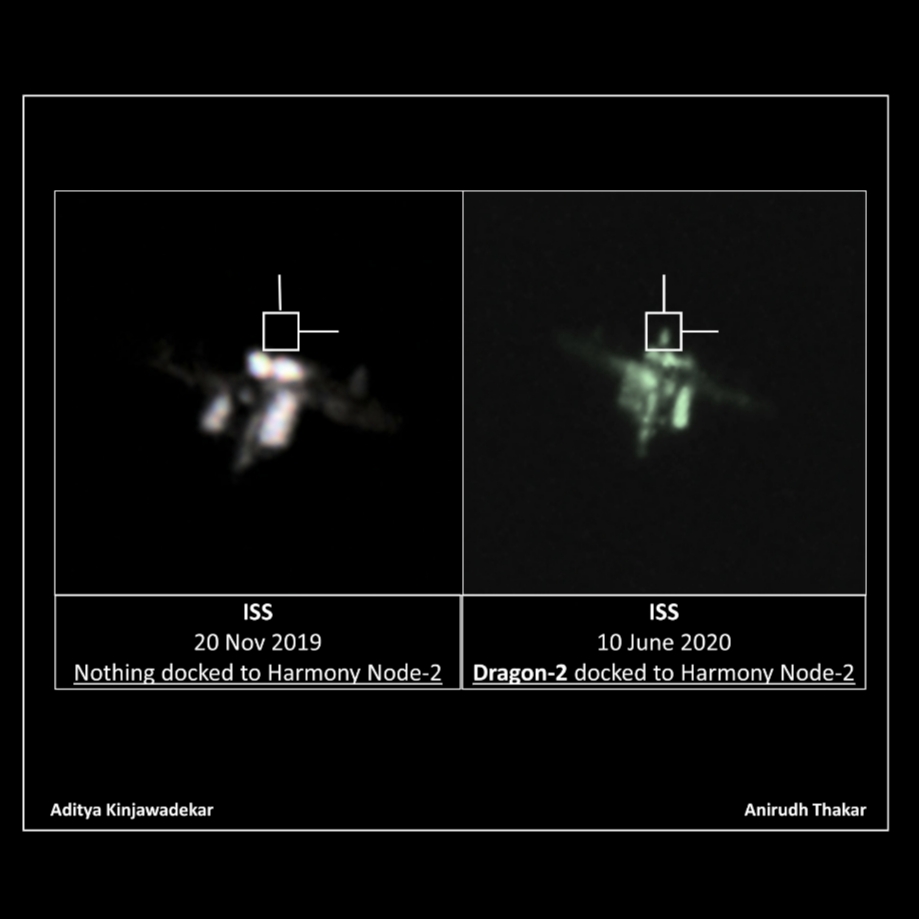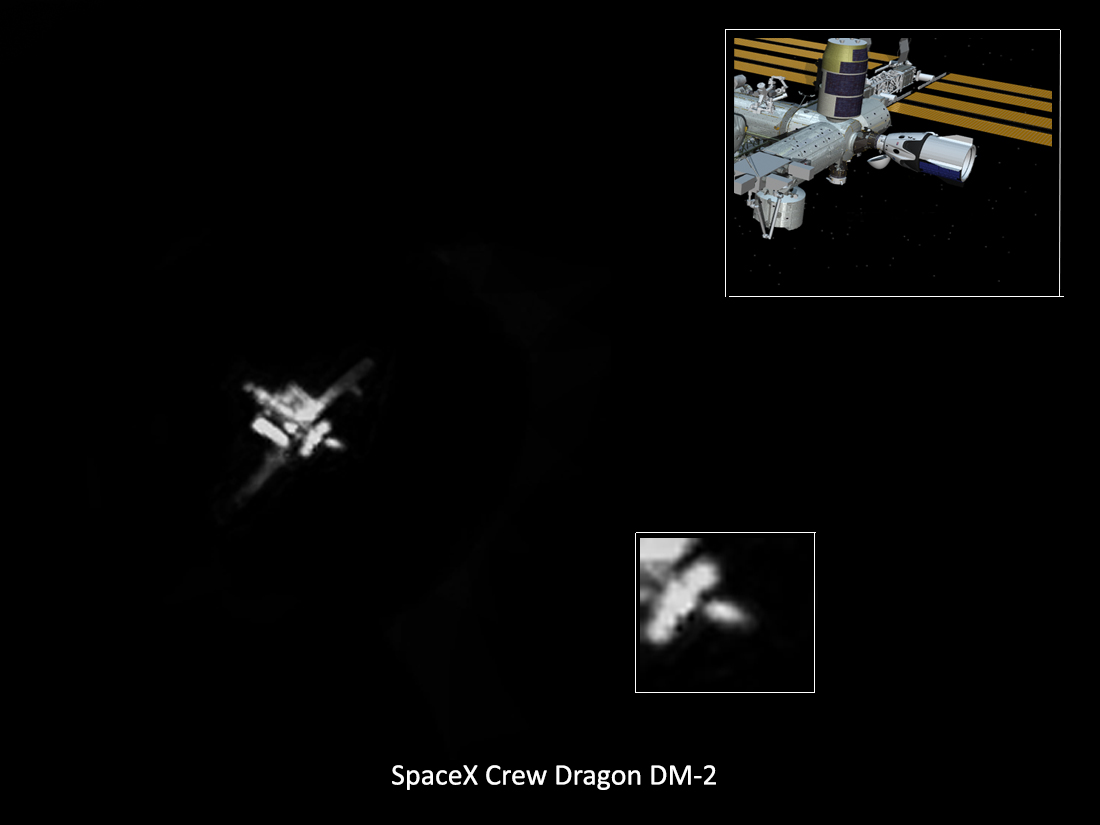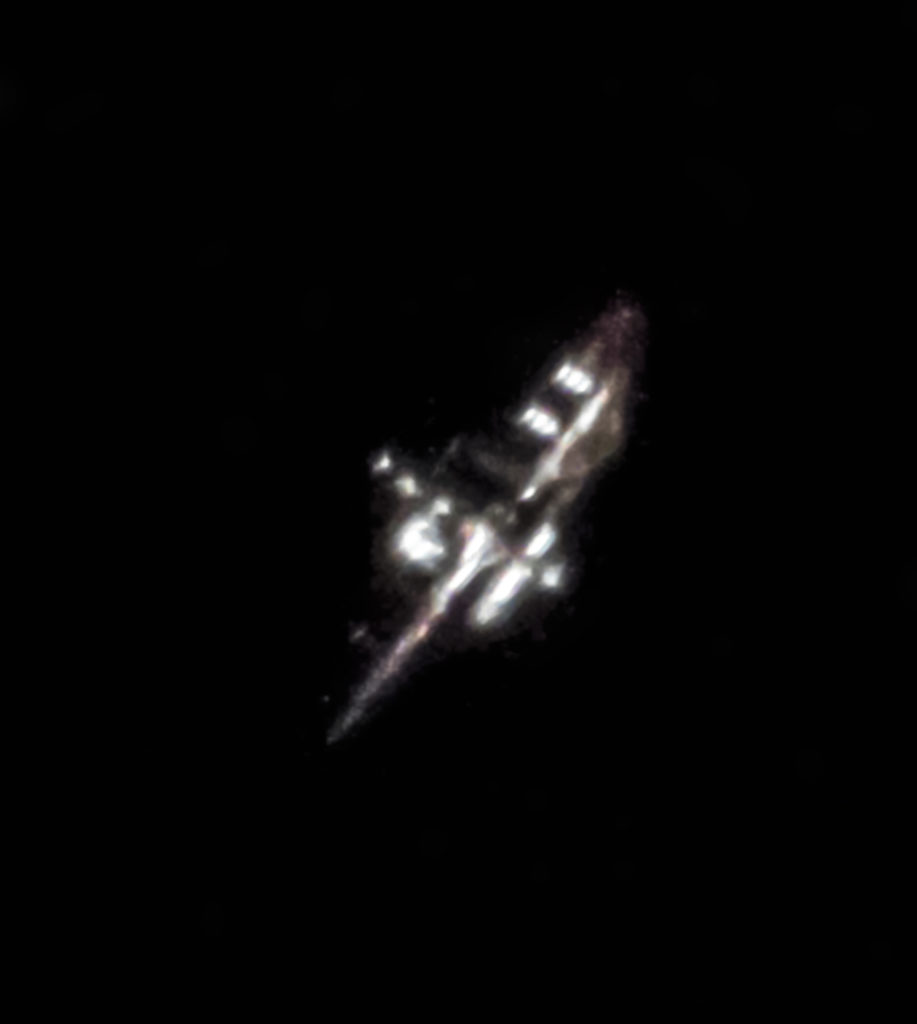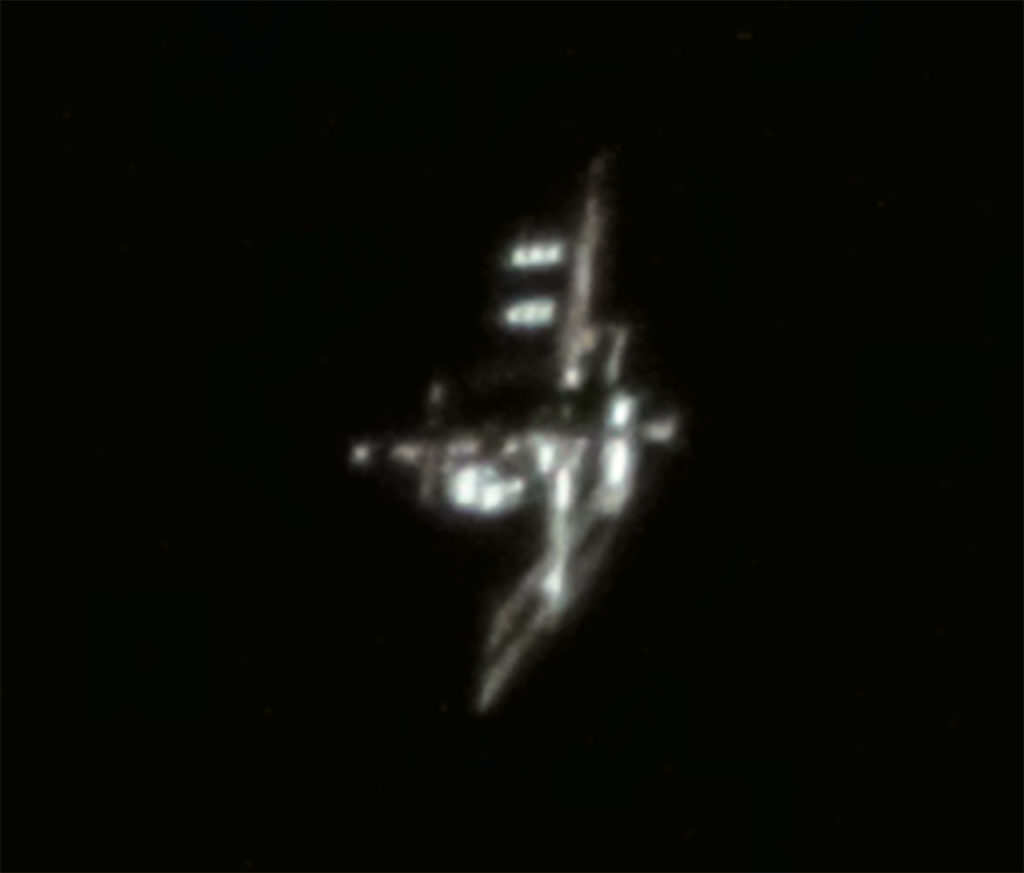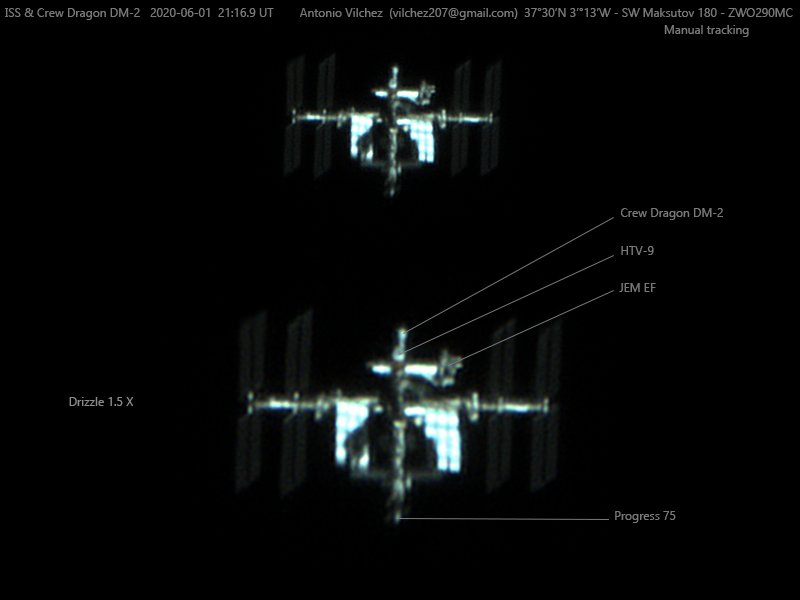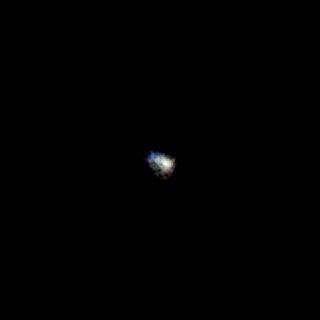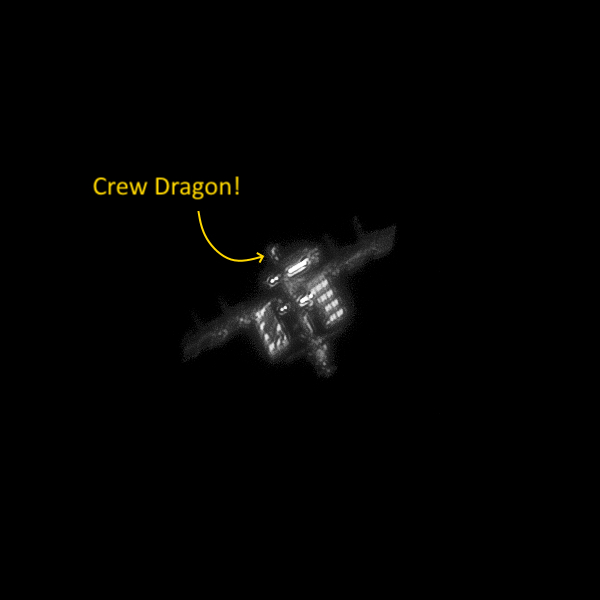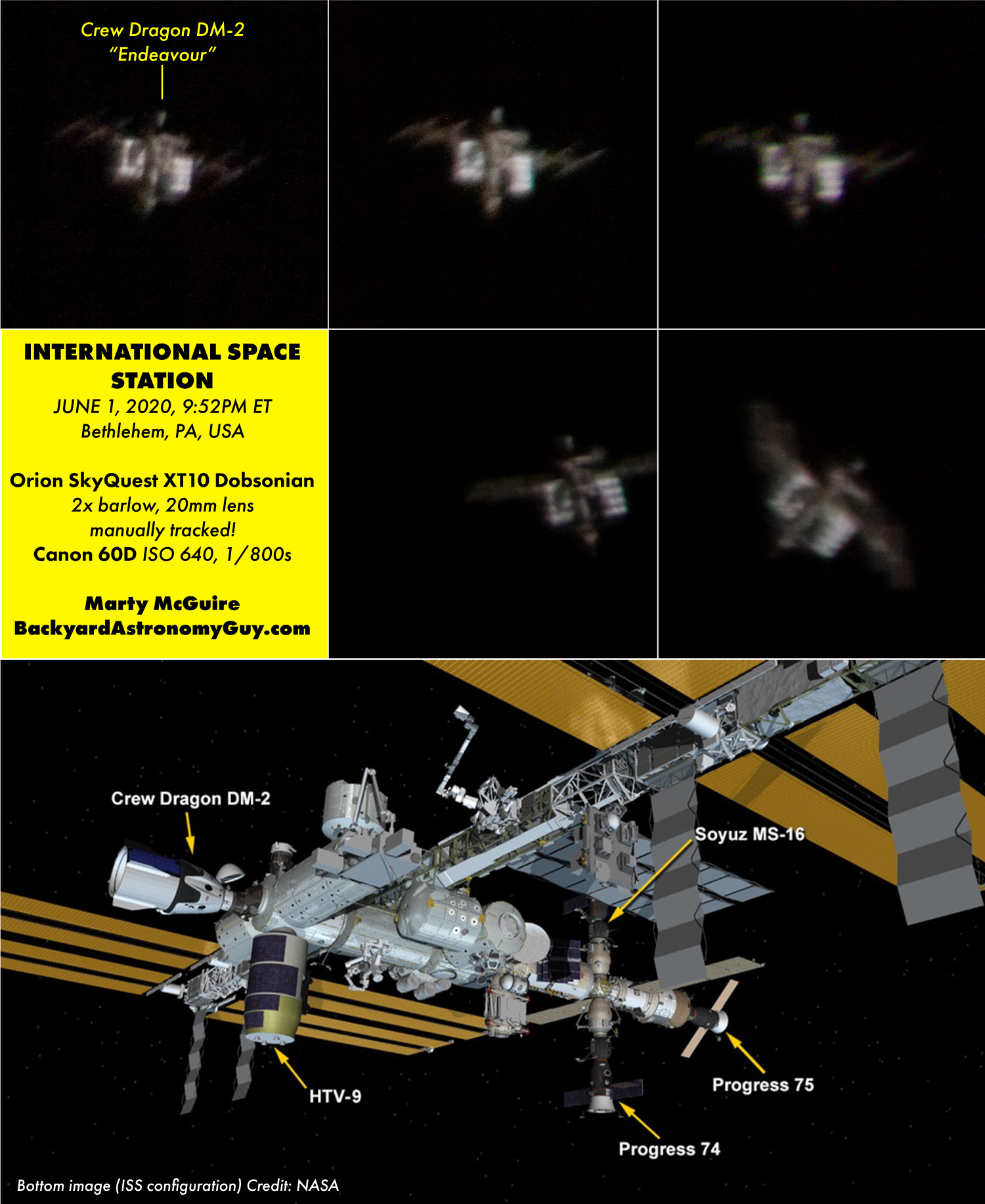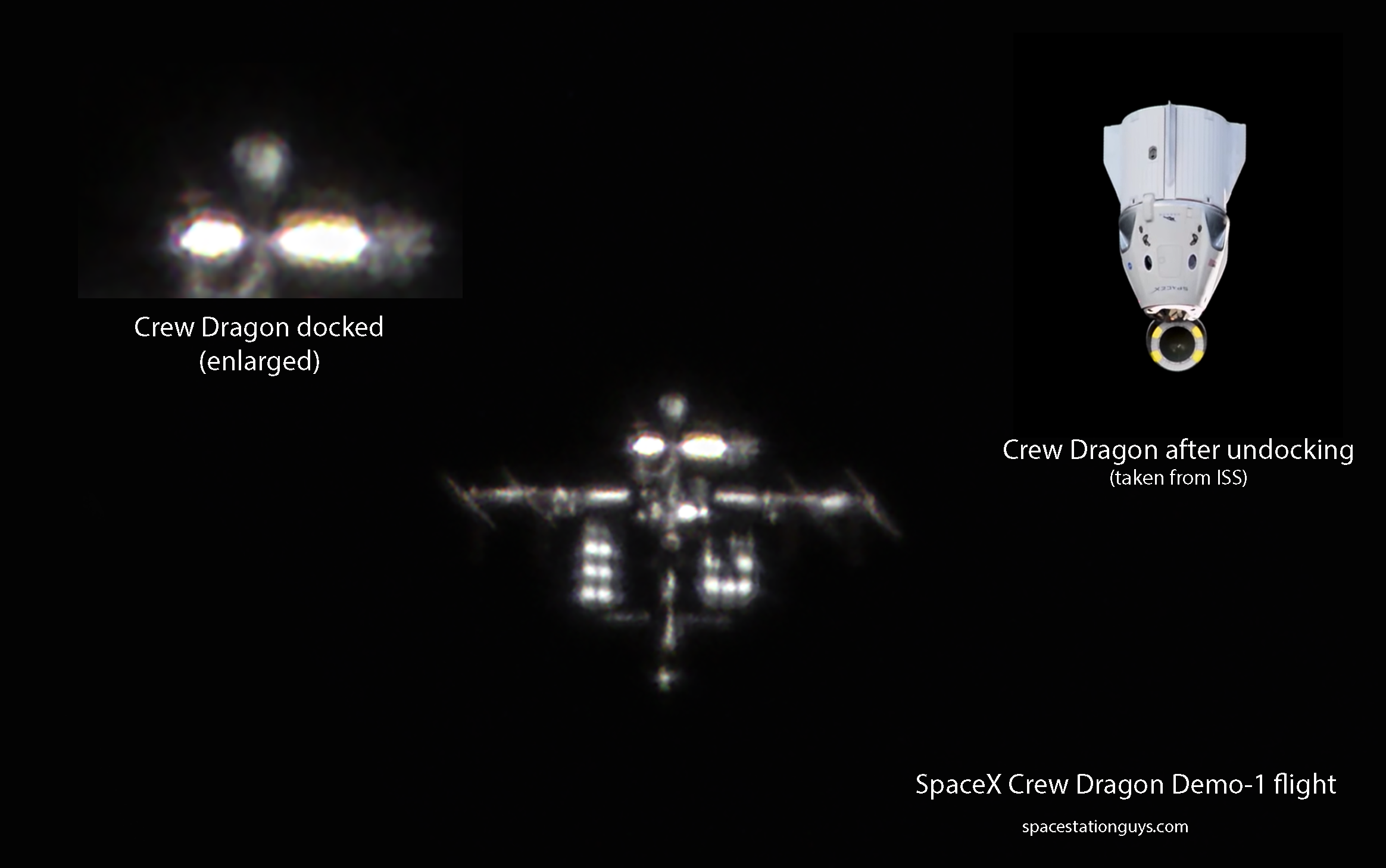In this page you will find photos of the International Space Station with SpaceX’s Dragon-2 spacecraft docked to it. All images are amateur ground based photos! If you have any photos of the current or previous Dragon-2 missions, please contact me on email address – metrolinaszabi@gmail.com!
By clicking on the amateur ISS photographer’s name below, you can explore their work on their preferred social media channel (Instagram, website, etc.). If you like their amazing photos, please do check out those links!
Jump to these topics: Demo 1, Demo 2, Crew-1/CRS-21, Crew-2
Crew-2 mission
7th October 2021
Tomo
Equipment information: Takahashi Mewlon-250 250mm F12 + Tele Vue Powermate 2x, Location: Ama city, Aichi, JAPAN, Time: 2021.10.07 9:12:39(GMT), Max elevation: 66deg.(459km), Mag.: -3.8, Sun altitude: -9.8deg.
13th July 2021
Brett & Justin Gottula
(Brett’s Twitter profile)
Special software for tracking. For full pass video click here.
This was one of those rare and special 89-degree elevation passes, fully illuminated horizon to horizon. I traveled to San Jose to avoid expected clouds close to where I live. To align the mount I ran custom software I’ve written over the past ~5 years which fully automates the process using only GPS and a guidescope camera. Besides speeding up the setup process this gives me the flexibility to aim the polar axis of the mount anywhere on the sky, which I use strategically to allow me to track the entire pass without a meridian flip in the middle even though I’m using an equatorial mount. To track the pass I ran software I’ve written which uses sensor fusion to combine predicted position from a TLE file and computer vision target identification in the guidescope camera. The only thing I had to do manually during the pass was control the gain of the camera while watching the histogram. Camera was set for 1ms exposure time, 3096×2080 resolution at ~60 FPS, 8-bit mode. For post-processing I used Rolf Hempel’s excellent PlanetarySystemStacker along with ffmpeg and some of my own Python/Numpy to do cropping and stabilization. The software development used here has been a collaboration between myself and my brother Justin who is an expert at reverse-engineering and working with buggy hardware drivers.
3rd June 2021
Michael Tzukran
Mount fork double-arm – 16 inch – zwo 174mm – yellow filter. Custom university software for calibration and guiding. Location: Tel-Aviv, Israel Date: 03.06.2021
6th June 2021
Vishal Sharma
Exif details: Exposure 0.96ms, Gain 71
28th May 2021
Csaba Torma
International Space Station flyby from Arad, Romania Date: 28.05.2020
25th May 2021
Michael Tzukran
Mount fork double-arm – 16 inch – zwo 174mm – yellow filter. Custom university software for calibration and guiding. Location: Tel-Aviv, Israel Date: 15.05.2021
25th April 2021
Tomo
Equipment information: Takahashi Mewlon-250 250mm F12 + Tele Vue Powermate 2x
Location: Ama city, Aichi, Japan
Date/Time: 2021.4.25 4:16:14JST (19:16:14 GMT on 24th)
Max elevation : 77deg. (434km) Mag.: -3.7 Sun altitude: -10.8deg.
Crew-1/CRS-21 missions
2nd April 2021
Philip Smith
I used an Edge HD 14″ telescope with an Astrodon Red filter on a ZWO ASI174MM (mono) camera and a Televue 1.8X barlow lens. ER Tracking software with modified EQ-G mount in and out.
22nd March 2021
Szabolcs Nagy
Equipment: Skywatcher 250/1200 dobson telescope, Zwo ASI224MC color camera, TeleVue 2.5x powermate, Bahtinov mask (focusing aid), Telrad (aiming aid)
19th February 2021
Tomo
Equipment information: Takahashi Mewlon-250 250mm F12 + Tele Vue Powermate 2.5x ZWO ASI174MM
Location: Ama city, Aichi, JAPAN
Time: 2021.2.19 20:48(GMT) 05:48(JST on the 20th)
Max elevation : 72deg.(440km) Mag.: -3.8 Sun altitude: -10.0deg.
6th February 2021
Tomo
Equipment information:
Takahashi Mewlon-250 250mm F12 + Tele Vue Powermate 2x
Location: Kiyosu City, Aichi, Japan
Time: 2021.2.6 9:33:01(GMT) 18:33:01(JST)
Max elevation: 82deg.(427km) – Mag.: -3.7 – Sun altitude: 14.1deg.
7th February 2021
23rd January 2021
Szabolcs Nagy
Equipment: Skywatcher 254/1200 dobsonian scope, Zwo ASI224MC colour camera, TMS Astro eq-platform Location: London, UK Date: 23.01.2021 Time: 18:34 UT
16th January 2021
Mohamed Al Maazmi
EDGE HD 8 (Manual tracking) ZWO 290MC, Zwo ADC & UV/IR filter 6:28 pm 16/1/21
8th January 2021
Michael Tzukran
Equipment: Upgraded C14 with Zwo174mm cool + GM2000 for upgraded + longpass filter Max. elevation: 79 deg pass, mag -3.8 Location: Tel-Aviv, Israel Date: 08.01.2021
19th December 2020
Michael Tzukran
Elevation: 73º
date: 19/12/2020 hour: 05:48 location: israel – tel aviv university
Captured via SharpCap, total 6 Frames stacked in AutoStakkert, minor enhancement in Snapseed.
8th December 2020
Alain Grycan
Toulouse
ISS, on 8th December 2020 at 18h24, culmination at 66°
C8, 1/1600s, 1600 ISO.
Tomo
Takahashi Mewlon-250 250mm F12 + Tele Vue Powermate 2x, Celestron Advanced VX (Japan Made Bearings installed in both RA and DEC), Manually tracked, ZWO ASI174MM
Location: Ama city, Aichi, Japan Time: 2020.11.21 8:36:37 (GMT) 17:36:37 (JST)
Max elevation : 71deg. Mag.: -3.6 Sun altitude: -10.9deg.
21st November 2020
Jonathan Grayson
Time: 5:38 PM Pacific Time Location: Wheatland, California, USA Gear: Celestron 1100 EdgeHD, CGEM DX, 2x Tele Vue barlow, ZWO ASI290MC
“This was my first successful shot of the Space Station, and to catch the visiting SpaceX Crew Dragon was a real treat! I have attempted this numerous times in the past and it was always a huge failure. The best image I had still looked like I’d tried to image a flying mosquito with my phone. But nevermind those past errors, I’d given it some though and wanted to try new settings and a new tracking approach.
I had been planning this shot all week knowing that the ISS would be transiting my home at a high angle and brightness. The day prior however, the forecast started calling for clouds which looked like it might ruin the opportunity. But, as night approached, it the clouds turned out to be high altitude thin ones. They were not idea, but the bright station was probably still going to be visible if the sky didn’t deteriorate more.
The pass happened shortly after sunset, so I was strapped for time getting the telescope focused and aligned properly before the station flew past. I found a star, and got things squared away with just about 5 minutes to spare. As soon as I saw the station, I hit record on my laptop and got myself ready to move the telescope around. Once it cleared the trees (at around 75° high) I quickly started to reposition the telescope using my Telrad finder to try and keep the station centered.
The entire visible transit lasted about 5 minutes, but my imaging window was limited to about a minute due to the trees and my patio covering. I ended up taking about 2.5 minutes of video having hit the record button early.
Afterwards, I rushed inside to watch the video and was a bit bummed to see that there didn’t appear to be anything there. But when I ran it through PIPP, it extracted 7 frames showing the station! I stacked those and edited them as I would any astro photo, and the result is what you can see here.”
Tomo
Takahashi Mewlon-250 250mm F12 + Tele Vue Powermate 2x, Celestron Advanced VX (Japan Made Bearings installed in both RA and DEC), Manually tracked, QHY174C camera
Location: Handa city, Aichi, Japan Time: 2020.11.18 9:21:38(GMT) 18:21:38(JST)
Max elevation : 59deg. Mag.: -3.6 Sun altitude: -19.8deg.
On the evening of 18th, I had to go to “Handa Celestial Science Museum” as a volunteer staff. So, I’ve brought my telescopes and set my gear at the parking lot of the museum. As It was partly cloudy, this shot was captured about 10sec before max elevation.
Mohamed Al Maazmi
18th November 2020
Astronomy Live
Filmed with a Blackmagic Pocket Cinema Camera 4K @ f/20 (2x barlow) 1/500s @ ISO 25600
Michael Tzukran
17th November 2020
Aditya Joshi and Bhushan S Karmarkar
Demo-2 mission
31st July 2020
Justin Davenport
I got a shot of ISS and Crew Dragon last night, at 10:35 pm Mountain from South Jordan, Utah. Taken with the C8/Canon T7i combo. 1/1000 exposure.
Mónika Landy-Gyebnár
Equipment: Nikon D5300, Tamron 150-600 + 2x extender Settings: ISO 2500, f13, 1/1600 – 1/2000 sec. exp., handheld camera Date/time: 31-07.2020 19:15 UT Location: Veszprém, Hungary
17th July 2020
Szabolcs Nagy
International Space Station photographed from London. My third occasion to take photos of the second Crew Dragon spacecraft, nicely visible docked to the forward end of Harmony module. The top photo is made of the best consecutive 19 frames stacked and post-processed. The animation is a short cut out from a video I’ve made – some of the features marked on the ISS
Equipment: Skywatcher 250/1200 Flextube dobson telescope, Zwo ASI174MM camera, TeleVue 4x powermate, Baader IR-Pass, Bahtinov mask
14th July 2020
Josh Palmer
13rd July 2020
Péter Piros
2020-07-13 22:17 UTC (2020-07-14 00:17 CET) – Piliscsaba, Hungary Equipment: 300/ f4 Newton astrograph (Orion Optics primary mirror), Fornax 51 equatorial mount, ASI290MM camera, 2X barlow, TS crosshair eyepiece, manually tracked
Marty McGuire
12nd July 2020
Szabolcs Nagy
Equipment: Skywatcher 250/1200 Flextube dobson telescope, Zwo ASI224MC camera, TeleVue 2.5x powermate, Bahtinov mask
11th July 2020
Ricky Goodyear
Equipment: Skywatcher 14” Dobsonian (f/11.6), ASI174MM (gain 240/shutter 0.75ms), Baader 685nm IR Pass filter. Flyby Details: Distance 428.8km, Angular Velocity 0.86°/sec, Altitude 60°, vis. mag -4.0 Location: Brisbane, Australia
7th July 2020
Szabolcs Nagy
International Space Station photographed from London. The second Crew Dragon spacecraft is nicely visible docked to the forward end of Harmony module. Note that also Canadarm 2 is visible on the animation – which I’m very happy too.
Equipment: Skywatcher 250/1200 Flextube dobson telescope, Zwo ASI224MC camera, TeleVue 2.5x powermate, Bahtinov mask
30th June 2020
Philip Smith
I imaged SpaceX Crew Dragon docked to ISS from my backyard Manorville NY USA 3:33am EST on 6-30-20 at Max 48°pass. Seeing was 3/5. I used an Edge HD 14″ telescope with an Astrodon Red filter on a ZWO ASI174MM (mono) camera and a Televue 1.8X barlow lens. ER Tracking software with modified EQ-G mount in and out.
29th June 2020
David Hash
All imagery taken with a Celestron EdgeHD 1100. The ISS+Endeavour photos were taken in color with a ZWO ASI290MC + ZWO IR/UV cut filter, and the older b&w image from February is with a ZWO ASI290MM + ZWO IR/UV cut.
24th June 2020
Mohammed Alabdulkareem
Equipment: Celestron C9.25+ 2X TV powermate. 10Micron GM1000 ZWO ASI174MM Location: Zulfi, Saudi Arabia Date/time: 24th June 2020 / 4:20am
22nd June 2020
Astronomy Live
Here’s my shot of DM-2 docked to ISS at sunrise. I tracked it using my open source software, though morning clouds confused the guide camera and the morning twilight kept me from locking onto the station until it hit about 30 degrees altitude over the horizon. This was my first time attempting to film a satellite with my Blackmagic camera, and the exposure speed ended up being slower than desired. You can still see the bright white DM-2 capsule docked to the forward PMA on ISS though. 6-22-2020 8″ Meade LX200 Classic @ f/20 (2x barlow) Blackmagic Pocket Cinema 4K, Florida, USA
10th June 2020
Anirudh S Thakar & Aditya Kinjawadekar
Now monsoon season in India, and hence the sky is almost always cloudy. But this evening there were intermittent low altitude clouds, and I felt the I could get at least some frames as it was too good a pass to be missed! Half an hour before the pass, it was drizzling a little bit, but the rain stopped. I quickly setup the scope, my friend, Aditya came over, and then suddenly, more clouds. Thunder and lightning! We thought this pass would be wasted. But at the minute of the pass (07.46 pm IST) the clouds thinned a little bit, and we could see the pass. So, we became satisfied! More so, when we learnt that the Dragon DM-2 is visible! All pictures were taken with the same equipment – 8 inch Dobsonian Telescope and ZWOASI120MC-S colour CMOS camera.
2nd June 2020
Josh Palmer
This image was taken with my CPC 1100 (Manually Tracked) and ASI224MC using FireCapture. It is a stack of 31 frames.
1st June 2020
Alexis Kwasinski
Two of my ISS images less than a minute apart from Pittsburgh, PA, USA. Captured using a CPC 925 with manual guiding, a 2.5x Barlow and an ASI224MC camera. Taken at 8:22 UTC (4:22 US EDT=Local time).
Antonio Vilchez
Csaba Torma
SpaceX Crew Dragon Demo-2 mission ‘Endeavour’ spacecraft shortly after launch over Romania Date: 30.05.2020 Location: Romania Equipment: SkyWatcher 200/1200 newtonian telescope, Zwo Asi 224 camera
David Hash
Last night’s images were taken with a Celestron EdgeHD 1100 + ASI290MM at prime focus, through a Astronomik 742nm IR pass filter. Full frame FOV is 7 x 4 arcmin, although everything you’re seeing here is cropped. Auto-tracked using a Celestron CGX and some home-brew tracking code. 1 ms exposures, and camera rolling at about 150 fps. Captured with SharpCap, frames extracted with SER Player, cropped/centered in PIPP, stacked with AutoStakkert!3 (15-30% keep rate), wavelet sharpening in RegiStax 6, then final adjustments in Lightroom.
Marty McGuire
Steve Mack
8″ zhumell dobsonian with 2x barlow lens. ZWO ASI290MC camera set at 0.505ms shutter speed and 390 gain. About 4 frames stacked in autostakkert, and wavelets sharpening in registax. 01.06.2020
Demo-1 mission
7th March 2019
Szabolcs Nagy
Enlarged comparison photo of ISS with docked SpaceX Crew Dragon Demo-1 (left) and the spacecraft after undocking – screenshot from the live feed (right) – Szabolcs Nagy
